CHAPTER THIRTEEN
AMERICA’S DIVISIONS DEEPEN
THE TRUMP PRESIDENCY – ROUND #1
Trump and the 2016 presidential elections
Hillary Clinton finally had her chance to run for the U.S. presidency. She was opposed in the Democratic Party nomination process principally by Bernie Sanders, an avowed Socialist. Backing her was big money − such as the billionaire George Soros − but also Blacks, Hispanics and women. Sanders was strangely supported by younger and more small-town America Whites. But Hillary pulled way ahead in the contest, even before the Democratic Party’s National Convention began.

On the Republican side, the nominating process was actually quite bizarre. Numerous candidates (17) stepped forward − and through a process of many televised debates the number dwindled as some of the contenders pulled out.

And those debates themselves were most strange, as they had less to do about actual policy matters than instead personality issues − most of them stirred by the personal attacks on his opponents offered by billionaire businessman and long-time TV host Donald Trump.
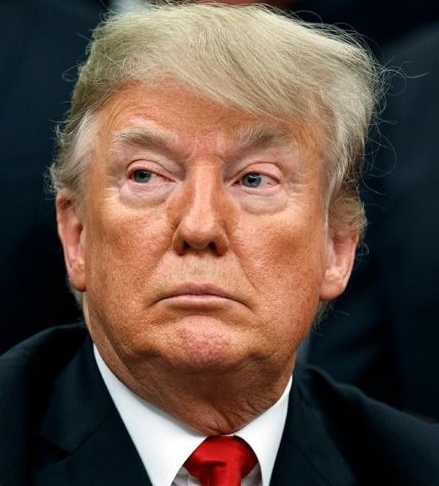 And even more strangely, Trump had absolutely no governmental experience − although years earlier he had tried a presidential run as the Reform Party candidate … and earlier had helped Democratic Party candidate Kerry in his 2004 presidential run.
And even more strangely, Trump had absolutely no governmental experience − although years earlier he had tried a presidential run as the Reform Party candidate … and earlier had helped Democratic Party candidate Kerry in his 2004 presidential run.
People considered Trump’s attacks on his Republican Party contenders to be most vulgar − but also most effective in keeping the spotlight on himself, until he was virtually the last man standing … and thus the Republican Party’s presidential nominee. But it would earn him the hatred of various Republicans − notably John McCain, whom Trump had ridiculed as a “patriot,” seeing him as someone who had merely been “captured” (shot down and imprisoned in a North Vietnamese prison).
What Trump proposed to offer the American people as their president was very difficult to figure out. He boasted that he would “Make America Great Again” (MAGA) − whatever that might mean. More specifically, he was really big on building a massive wall across America’s southern borders to stop the flood of illegal immigrants into the country − by having Mexico pay for the very expensive wall. That was not going to happen. But what was?
Making the campaign even trickier was the effort by Hillary’s campaign to connect Trump with supposed massive Russian support − although little was done at the time, as Hillary (and the national news media) supposed that she had an easy ride into the White House.
Wasn’t she surprised with the election results! Hillary won the national vote, 65.9 million (48%) to Trump’s 63 million (45.9%). But Trump had campaigned selectively in order to win the crucial electoral college vote, Trump gaining 304 of those votes to Hillary’s 227 votes. Thus Trump, not Hillary, would be entering the White House the coming January 20th.
Protests against the Trump presidency were quick to form, Trump representing everything that the Obama administration and judicial appointments had been fighting: “White privilege, toxic masculinity, homophobia and Christian superstition and anti-progressive religious doctrine. “
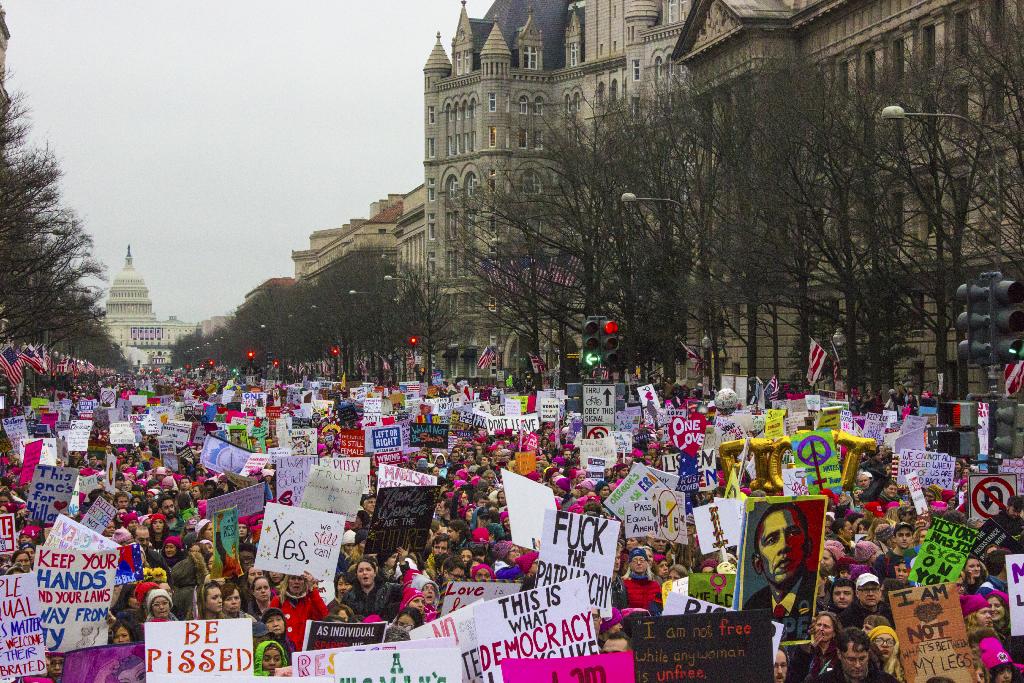
Thus there were the pink “pussyhat” protests staged by women across the country the day after Trump’s inauguration in January … and similar Facebook-organized “Not My President” protests held on Washington’s birthday in February.
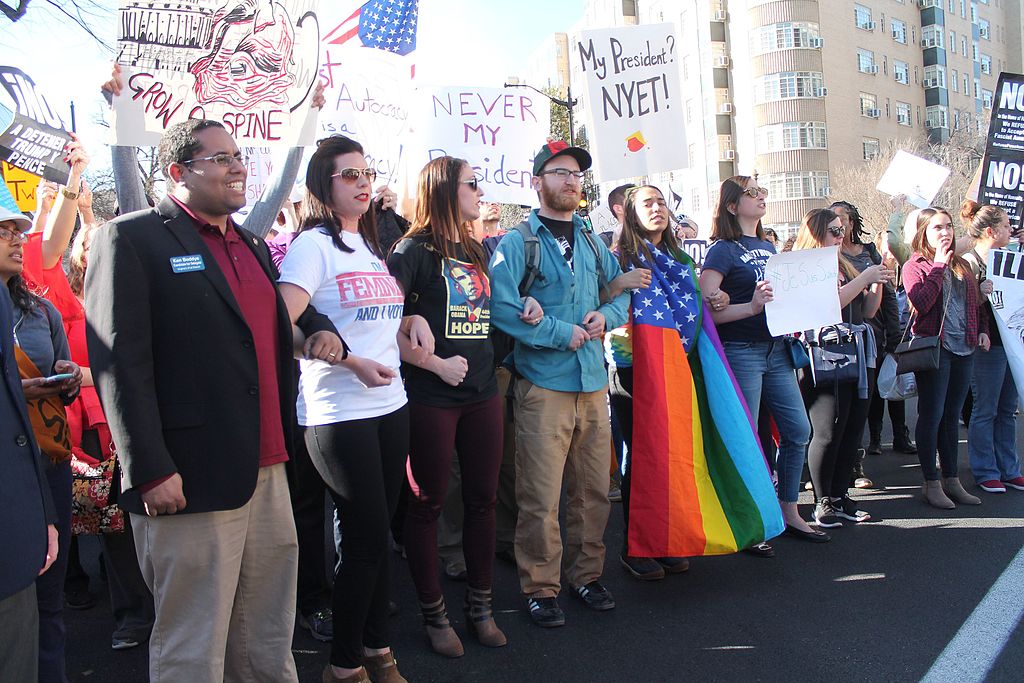
And Congress itself – at least the Democratic Party portion of Congress – immediately got the ball rolling for the impeachment of Trump … on the basis of the supposed Russian support that Trump had received during his presidential campaign.
And that would fairly well summarize the American situation during the “Trump era” – an intense bitterness between Trump supporters and Trump adversaries dividing the nation deeply. It would never let up … even when Trump settled into what otherwise appeared to be a rather normal presidency.
The making of Donald Trump. Trump was born in 1946 (just months apart from both Bill Clinton and Bush, Jr.) and came from a family line of successful entrepreneurs, especially his father, who developed a huge post-war housing construction and landowning company in New York City’s boroughs of Queens and Brooklyn. Trump was the fourth of five children, raised as a very prosperous Middle-American Christian (Presbyterian), his brothers and sisters themselves going on to various successful careers. But he himself was viewed as the individual most likely to take up his father’s business career, and eventually studied at the Wharton business school at the University of Pennsylvania. And with $1 million in support from his father at graduation, he started up his own New York construction business in Manhattan.

Trump and his real-estate developer father at Trump Village, Brooklyn – 1975
Step by step his business developed, not only in New York but in other cities and in other enterprises: a casino, an airline, parks, a football team, beauty pageants. At the same time, he rebuilt the Mar-a-Lago estate in Florida as his personal retreat, married the pretty Czech athlete Ivana Zelnikova … and together they had three children. By 1987, with the publication of his long-standing New York Times best-seller autobiography, Trump: The Art of the Deal, he was one of Gallup Poll’s top-10 best-known Americans at the time.
But his world would crumble in a huge economic recession hitting him (and others) that same year. He avoided bankruptcy … but his business world went into a deep slump – as well as his marriage, when his affair with Marla Maples was discovered. He and Ivana divorced in 1992, he married Marla the next year, but they separated in 1997 and divorced in 1999.
But his business world did make a comeback during those years, allowing him to publish his book, The Art of the Comeback in 1997. He had also, in the meantime, met the Slovene Model, Melania Knauss, whom he would finally marry in 2005 (with celebrities, including Bill and Hillary Clinton, attending!).
Meanwhile, in 2003, he decided to enter the world of television, becoming producer and host of the popular NBC show, The Apprentice, Trump grilling contestants to see who would have the privilege to intern with him in his ongoing business world. Eventually the contestants included celebrities, resulting in the renaming of the program in 2008 as The Celebrity Apprentice.

As mentioned earlier, he had made some minor attempts to enter the world of politics … before his decision in 2015 to go full blast at the Republican Party presidential candidacy. In doing so, he employed the same careful calculation by which he had built up his huge business empire, pulling ahead of his competitors, first of all to gain the Republican Party presidential nomination, and then to conduct a carefully strategized move to win the electoral college votes needed to gain the presidency itself.
No, Trump was no nitwit. Vulgar and abrasive at times, yes. Misleading in his broad public statements about what he planned to do with respect to this issue or that, often yes. But a nitwit. No.
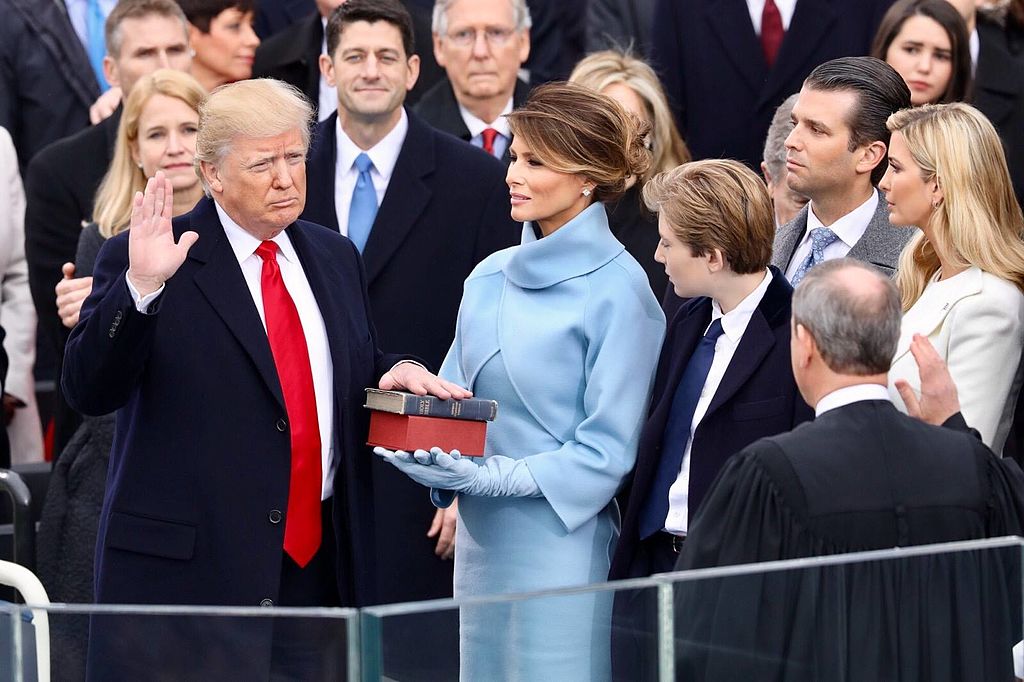
Trump as a Christian. For most of his life, Trump identified himself as a Presbyterian … although his church attendance was rather nominal and his actual awareness of details of the faith rather minimal. Eventually he would drop the Presbyterian identity and simply present himself as a non-denominational Christian. He did have close contact with numerous conservative pastors, especially Paula White, whom he identified as his personal pastor and who delivered the prayer of invocation at Trump’s inauguration.

And he was quick to oppose anti-Christian political policies that ran strong in D.C. – and America in general. But where his personal relationship with God stood would remain a great mystery to Americans.
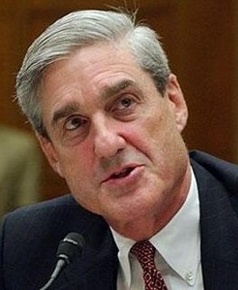 Impeaching Trump. Congress (all Democrats and even some Republicans) proceeded immediately to call for a special investigation into reports of a Trump “Russian connection” (Trump having supposedly received Russian support for his presidential campaign), resulting in former FBI Director Robert Mueller being appointed to serve as Special Counsel directing the investigation. Meanwhile the media went wild speculating about the wonderful outcome of the effort, namely Trump’s impeachment and presidential ouster in his having committed “high crimes and misdemeanors.”
Impeaching Trump. Congress (all Democrats and even some Republicans) proceeded immediately to call for a special investigation into reports of a Trump “Russian connection” (Trump having supposedly received Russian support for his presidential campaign), resulting in former FBI Director Robert Mueller being appointed to serve as Special Counsel directing the investigation. Meanwhile the media went wild speculating about the wonderful outcome of the effort, namely Trump’s impeachment and presidential ouster in his having committed “high crimes and misdemeanors.”
But they would be deeply disappointed when, in his March 2019 report, Mueller concluded that though he did not approve of some of the things Trump did, he could find no basis for criminal charges to be brought against the president. Indeed, it was only slowly realized that the Russian-connection rumors were the result of the Hillary campaign having hired former British MI6 investigator Christopher Steele to come up with dirt on Trump … Steele himself later confessing that he had used what he had supposed was CNN research material, only later realizing that they were merely unverified postings to a discontinued CNN website, unconnected directly with CNN’s research.
Okay … they were not going to be able to get Trump on the basis of the Russian connection. But surely they would find something else they could use to get rid of this evil president.
Trump’s Federal Court appointments. A Supreme Court position that became vacant in the last days of the Obama administration when Conservative Justice Antonin Scalia died, Obama was himself unable to fill because of a Republican-dominated Senate. But now with Trump as president, a similarly Conservative Neil Gorsuch was quickly nominated and confirmed by the Senate in a 54-45 vote − along purely Republican-Democratic Party lines. Okay, a conservative to replace a conservative.
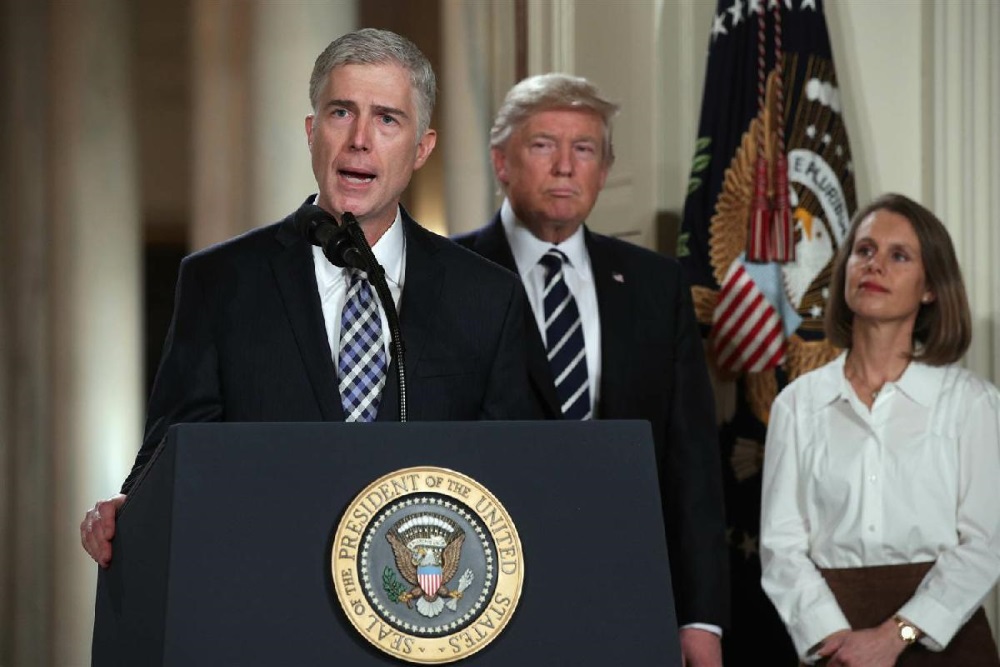
But when “Centrist” (originally a Conservative who drifted somewhat leftward over time) Anthony Kennedy decided to retire (2018), this gave Trump the opportunity to put another Conservative, Brett Kavanaugh, on the Court.

The Left immediately went on the attack, finding a woman, Christine Blasey Ford, who claimed that she had, 36 years earlier, been accosted (“feared for her personal safety”) by a group of drunk boys at a high school party, one of them having been Kavanaugh … though she did not know who he was at the time.
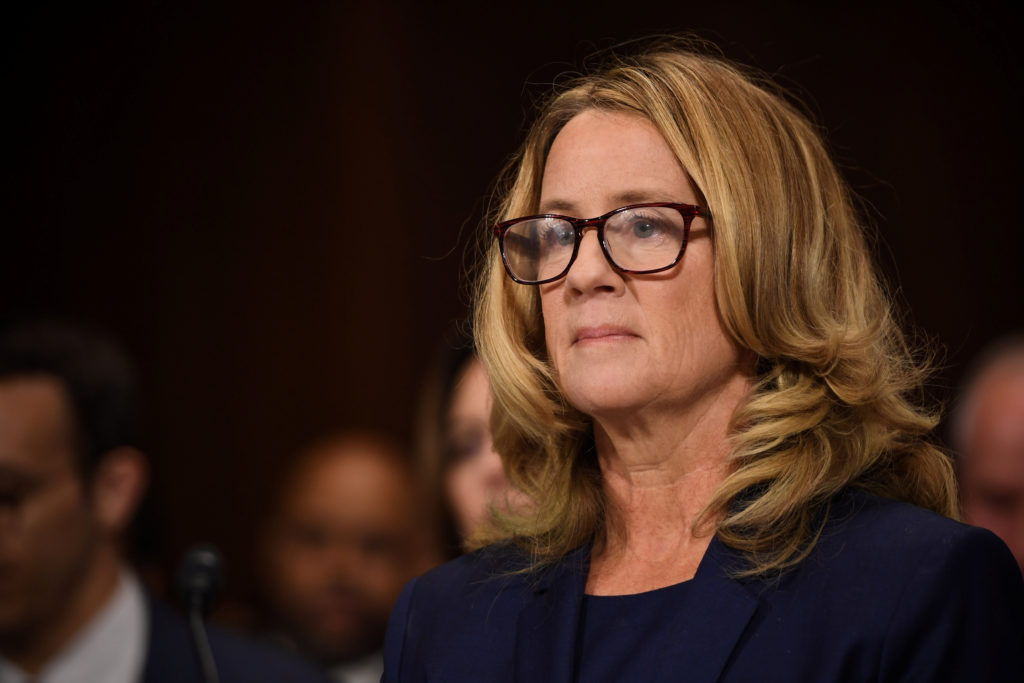
But friends who knew him back then stated that this in no way fit Kavanaugh’s personality. And a friend of hers who was with her at that same party remembered no such event ever having taken place. And his record as a judge was spotless. Nonetheless, the media most gladly took Ford’s side of the story, playing the ever-popular female-victim narrative … and depicting Kavanaugh as this most horrible individual. But once again, the Democrats had no other way to fight this Court appointment. Subsequently, Kavanaugh was approved by the Senate, 50-48 (one Democrat supporting, two independents opposing).
 Then in September 2020, shortly before the coming national elections, very Liberal (and Jewish) Ruth Bader Ginsburg died, allowing Trump to make yet another Conservative appointment, Amy Coney Barrett, to the Court.
Then in September 2020, shortly before the coming national elections, very Liberal (and Jewish) Ruth Bader Ginsburg died, allowing Trump to make yet another Conservative appointment, Amy Coney Barrett, to the Court.
Despite the American Bar Association giving her their highest recommendation, for “integrity, professional competence and judicial temperament,” the Democrats did what they could to block her appointment. But ultimately the Senate confirmed her, 52-49 (one of the Republicans actually voting with the Democrats).
Thus her appointment probably heightened the fear considerably of the Democrats that the Supreme Court would be even less likely than ever to be the ultimate recourse to put their “progressive reforms” into place by decree.
But they had not yet had the opportunity to see what a Democratic White House (soon-to-be-President Joe Biden) would be able to achieve simply through issuing multitudes of executive orders (presidential decrees) as the law of the land.
The 2018 Congressional elections. These Congressional elections turned out to be something of a surprise. Usually the party in power experiences something of a setback in the elections, due to voter disappointment about the way things seemed to be going at the time. And indeed, the Democrats picked up significant seats (41) in the House elections, now allowing them the much-desired majority there. Thus impeachment against Trump could now proceed … on the basis of some kind of charge against him.
And they would have some very interesting novices to make the House changeover even more dramatic – and give the press something to celebrate … three new and quite young females: two Muslims and one very outspoken Hispanic!
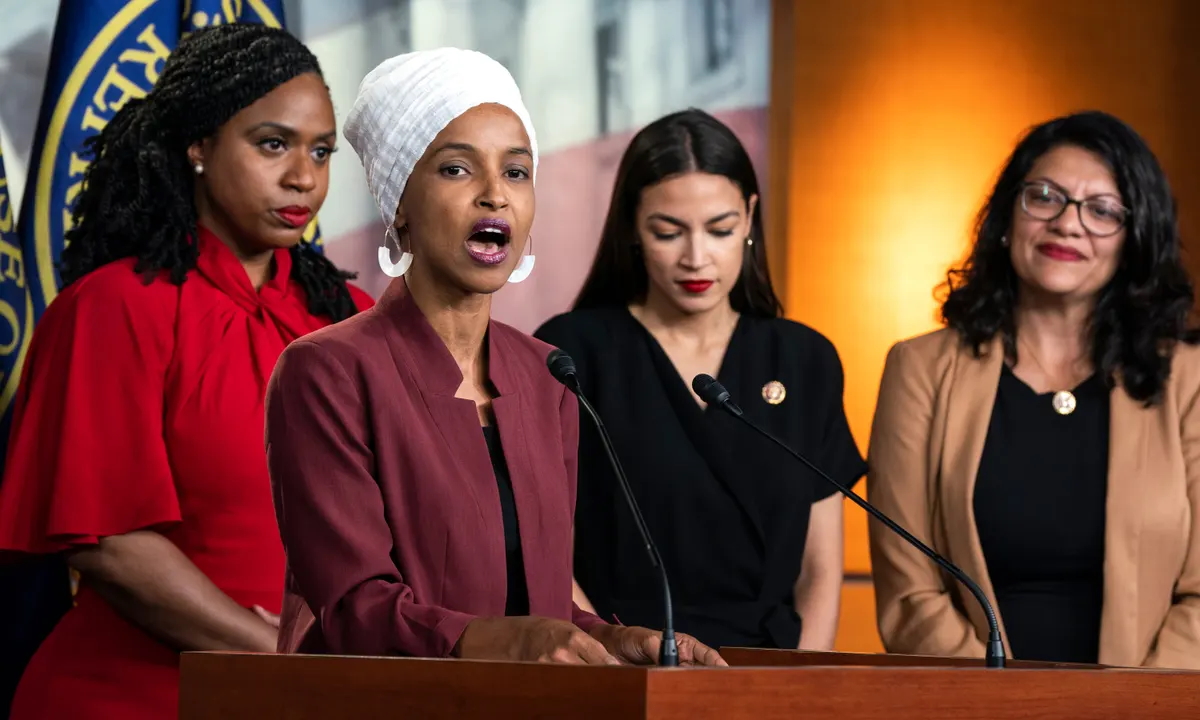
Affectionately known as “The Squad.” Speaking is Ilhan Omar, behind her (left to right) is Ayanna Pressley, Alexandria Ocasio-Cortez and Rashida Tlaib
But most surprisingly, the Republicans picked up two seats in the Senate, thus increasing the size of their majority there to 53 seats! That was not what the Democrats were expecting.
More impeachment. The Democrats finally saw their opportunity to go at Trump again when it was revealed that in July of 2019 Trump had made a phone call to Ukrainian President Volodymyr Zelensky, asking him to look into issues of corruption concerning American financial aid going to Ukraine. Trump (and Obama before him) was concerned about how that money seemed to drift off into private pockets. Trump informed Zelensky that he was holding up the release of some $391 million in military aid to Ukraine, pending some cleanup of such corruption.
Now it just so happened that former Vice President Biden’s son, Hunter, found himself (2014-2019) on the board of directors of Burisma, a Ukrainian natural gas company well-known for its corruption. Had Hunter Biden been placed there to clear up such corruption, or had his $50 thousand monthly salary itself been part of the problem?
The legal problem that the Democrats were hoping to go on was that Hunter’s father, Joe Biden, was at that point running for the American presidency, and this kind of anti-Biden maneuvering by Trump of a “Ukrainian connection” violated the electoral laws that made foreign involvement in American political campaigning highly illegal.

Joe Biden and his son Hunter
The only problem was that holding up funding pending the clearing of corruption was not itself illegal, but in fact something supported widely in America. And Trump himself admitted quite readily that he had indeed made just such a call. Furthermore, bringing to light Hunter’s involvement with Burisma was likely to be most unhelpful to the Biden presidential campaign. So ultimately, the Democrats decided to back off on the Ukrainian-connection ticket.
What then? The Democrats now decided simply to subpoena Trump, forcing him to come before Congress to answer various questions they wanted to ask him. But Trump was in no mood for such a political interrogation and simply refused to answer the subpoena. So that itself now seemed to give the Democrats the opportunity to impeach Trump for “obstruction of Congress” and “abuse of power.” And thus they had the opportunity that December to pass (along purely party lines) impeachment charges … charges that ultimately were headed nowhere because there was no likelihood of the Senate offering a conviction on those charges.
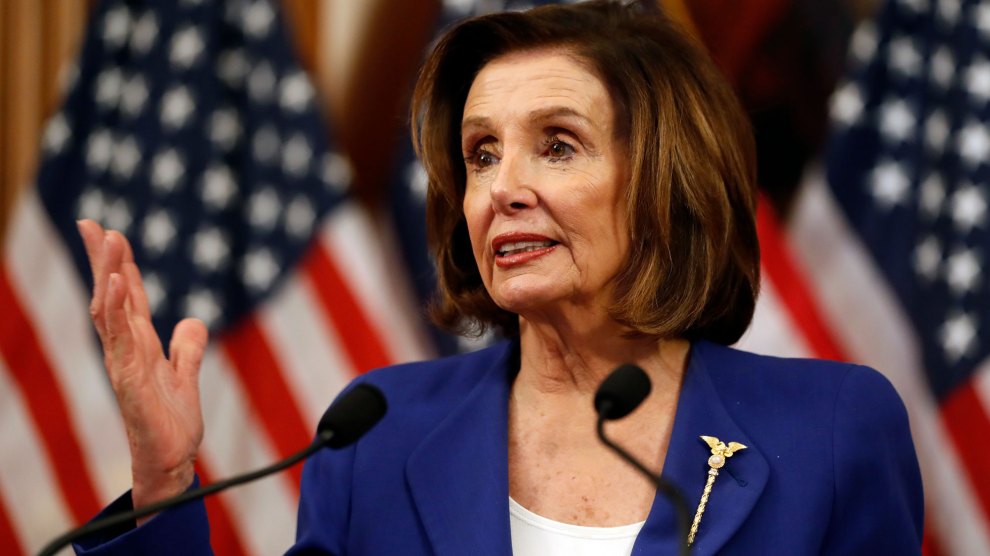
Democratic Party House Speaker Nancy Pelosi … directing the “Impeach Trump any way you can” movement in the House
So why did they keep doing this? Apparently, impeachment is now a regular feature of Congressional politics, designed to give Congress (or at least one side of Congress’s deep political divide) the public appearance of being true crusaders for virtue and integrity … and the press something to keep their constant 24/7 “news” service fully entertaining.
But morally speaking, this kind of behavior raises more moral questions than it resolves.
International challenges
Immigrants. Trump did not get Mexico to pay for that 1,954-mile wall designed to keep Central Americans from fleeing to America in order to escape the chaos in their countries. But he did have work done on the wall, mostly repairs, and a small amount of addition to a now 450-mile wall. And he did get Mexico to cooperate in slowing up the massive caravans of refugees heading through Mexico on their way to America.
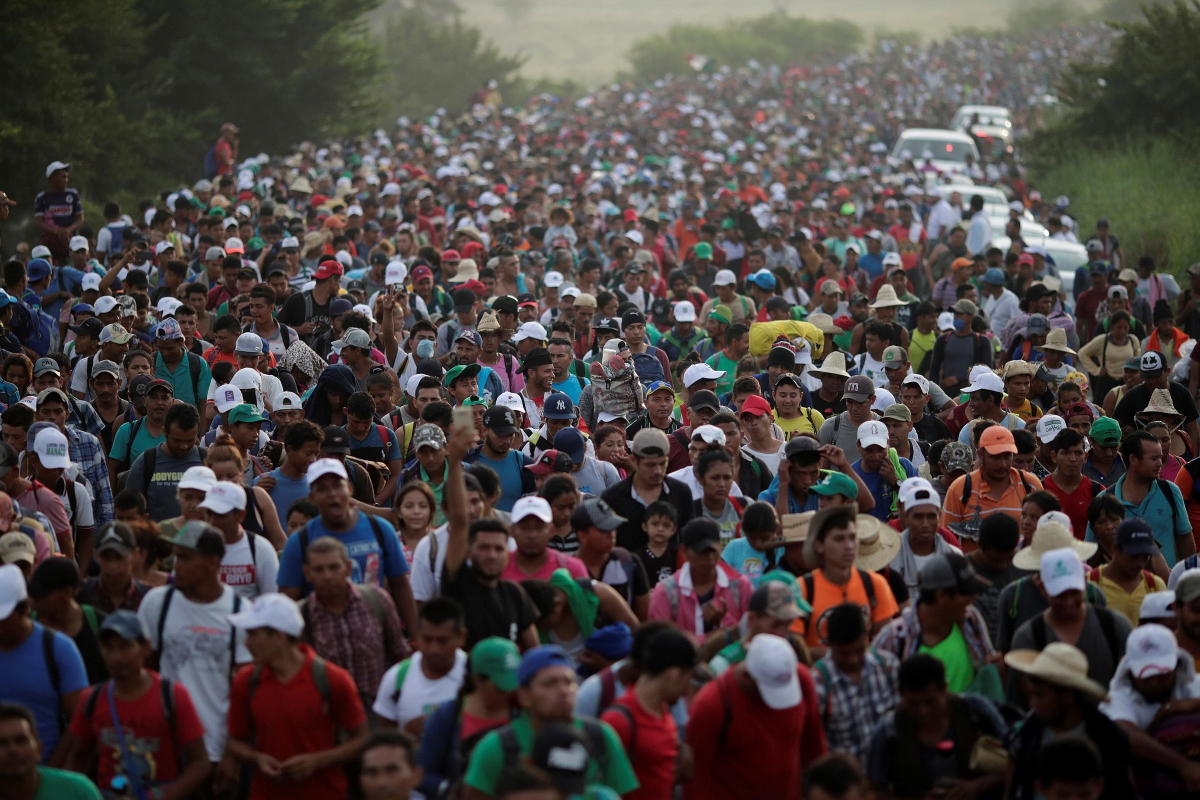
Central Americans on their way North – 2018
Refugees would now be required to remain in Mexico until they could be processed for legal entry. Of course, highly illegal human trafficking would continue to take place in the unfenced areas where it was very difficult to patrol.
American trade with Mexico and Canada. Trump also came down hard on Mexico (and Canada to a lesser extent) because of the way Mexico used the Value Added Tax (VAT) to subsidize Mexican imports to America … at the same time taxing heavily American exports to Mexico. VAT was a clever way of manipulating international commerce, actually invented by the Europeans, by simply holding off the taxing of industrial profits until the goods they produced hit the market as finished products. Now if those goods were sent abroad for sale, they avoided the cost of the VAT. At the same time, imports were hit hard with that tax, even though the production of those items had not taken place in their country. In short, VAT served not only to subsidize a country’s exports, it served as a very expensive tariff protecting domestic production.
So Trump went after the Mexicans – and the Canadians – terminating the Clinton-era tariff agreements (the North American Free Trade Area or NAFTA) and, after a year’s negotiating the matter, finally (November 2018) got an agreement to bring trade closer to parity with his new U.S. Mexico Canada (USMC) Agreement. But the Democrats, just taking power in Congress, were not in any hurry to reward Trump a trade victory, and would not sign on to his new pact until (late 2019) Trump had agreed to add some environmental and labor actions to the measure.
China. But China posed an even bigger challenge in this matter of not only international trade, but the status of the dollar as the world’s foundational currency. China had been very busy working to undercut that American position, trying to set up an alternative global economic system in which China would now be the centerpiece. The goal was to achieve this status by 2035. And the Chinese were very busy on this matter.
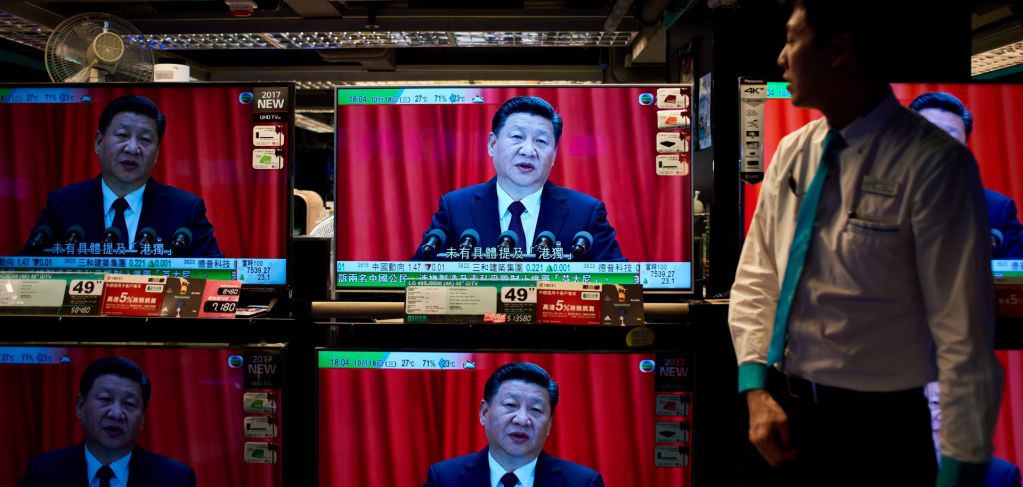
Hong Kong televisions tuned to China’s 19th Party Congress … with Xi explaining the directions China will be taking as it elevates itself to the status of superpower (perhaps soon to be the world’s sole superpower)
First of all, there was BRICS, actually formed at the end of the 1990s, which brought Brazil, Russia, India, China and eventually South Africa together to try to form a new multinational organization designed to coordinate their economic policies. With by far the largest economy, China clearly dominated BRICS. Headquartered in Singapore, the organization worked hard to find ways to finance trade and investments … without having to resort to using the dollar to do so.
Then there was China’s “Belt and Road Initiative,” started up in 2013, designed to integrate the numerous participants in the program with the Chinese economy.
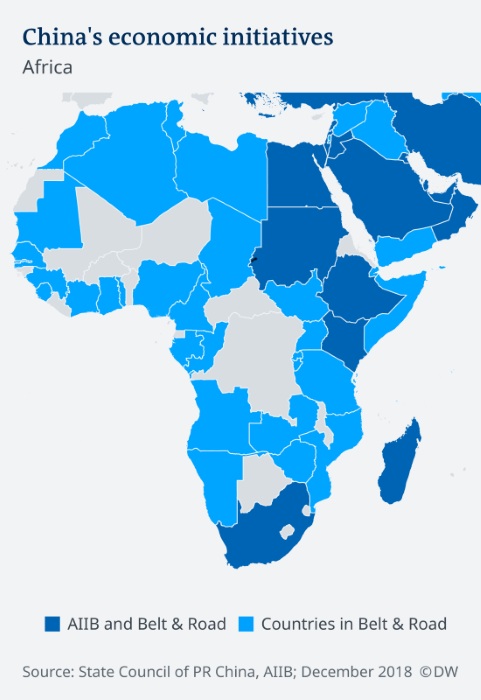
Russia gladly joined. India did not. But in 2019, leaders of some 40 countries gathered in Beijing to celebrate the program’s success. Most interestingly, included in that group were Poland, Hungary, Serbia, Greece, Italy, Spain, Czech Republic, Switzerland, Turkey, Chile, Argentina … countries that America has long looked to as allies or friends of some sort.

And Putin’s Russia was working very closely with China in developing China’s Maritime Silk Road, now (thanks to Arctic melting) reaching from China to Europe across the newly opened waters along Russia’s northern coast. And Russia was very happy to send natural gas to China by way of its new pipeline.
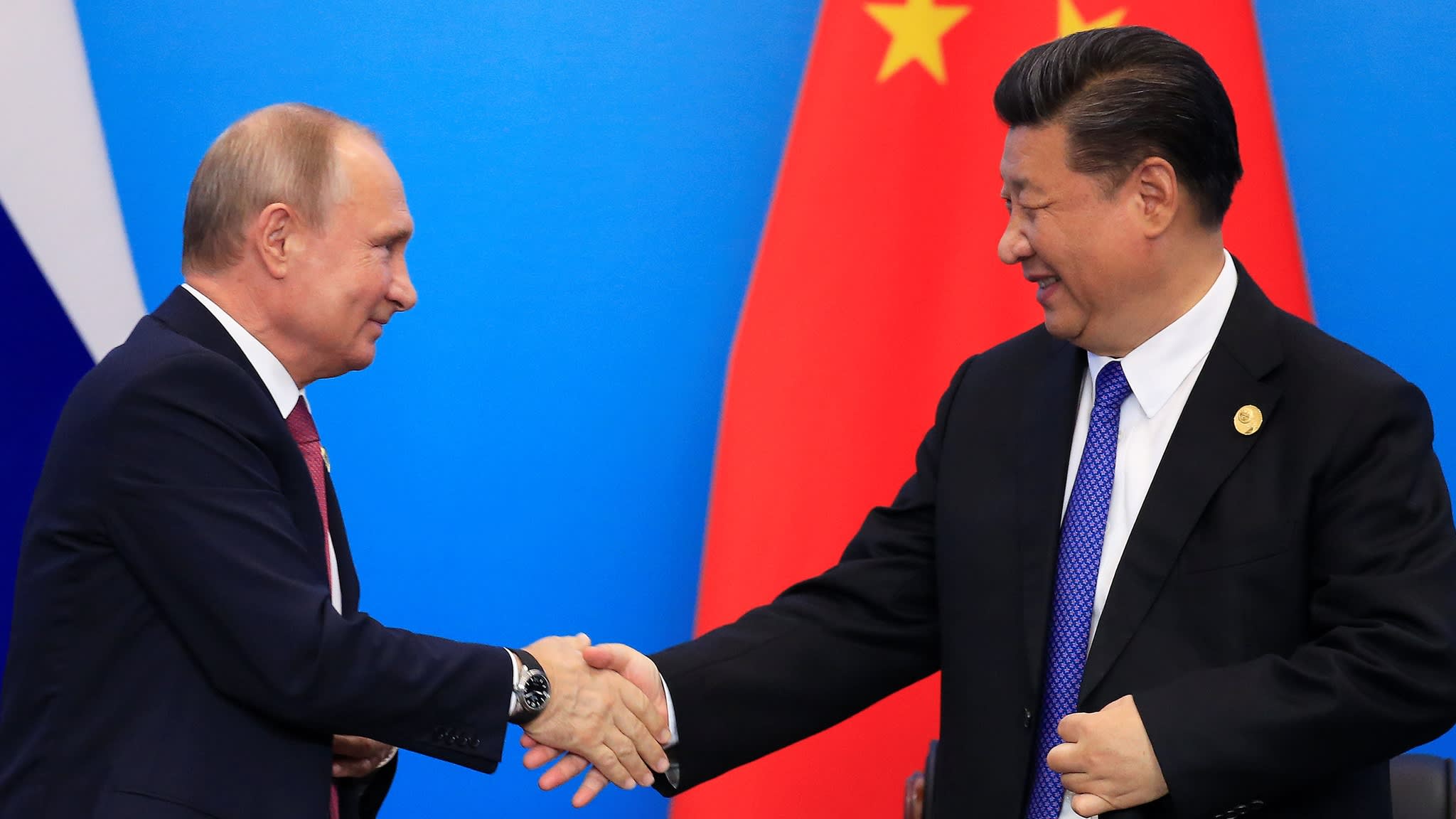
Putin and Xi working closely together – June 2018
Meanwhile, Trump had decided to slow up the trade of Chinese goods into the American market … actually flooding the American market with high-tech and cheaply-produced consumer items. The Chinese had purposely subsidized deeply the development of such industry simply to put China in a very strong trading position. And they had also protected Chinese industry by imposing high tariffs on imports. Thus, for instance, the balance of trade between America and China was lopsidedly favorable to China. Thus in March of 2018, Trump imposed his own $250 billion tariff on Chinese goods entering America. But then China simply retaliated with their own $100 billion tariff on American goods coming to China. Attempts were then made in 2019 to get Trump and Xi together to work out a lowering of those tariffs. But little came of the effort … except for other Western countries to try to slow up the flood of Chinese goods into their markets.
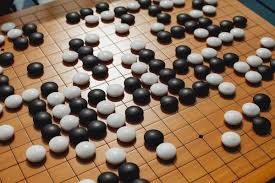
Here’s where Western and Chinese ways of going at challenges differ deeply. Westerners go at things – wars for instance … and even trade wars – by direct assault on the adversary. It of course takes some maneuvering to gain that goal … something like a chess game. But the Chinese go at things differently. They have their own ancient and greatly beloved board game, wéiqí, better known to the larger world as “Go.” The game is played on a large checkerboard (19 x 19 squares), players taking turns placing their black or white stones on these squares in a way to surround the adversary’s position. The game continues until one of the players can make no further moves.
And so the Chinese are doing the same, in heading to countries across the world, even small ones, to “help” them develop their economies – planting Chinese infrastructure there in the process. Westerners are not paying great attention to the game, because those smaller Chinese involvements seem to be mere “side issues.” To the Chinese they are not. And little by little, they are gaining on the plan to make China, not America, the centerpiece of the world’s economy. And unlike American politics, which can change dramatically every four years, the Chinese support fully a long-term leader who is expected to keep China moving forward in pursuit of that particular national plan.
The Muslim world. Trump seemed unimpressed with the idea that America’s job in the world was to bring “democracy” to the world … as it had attempted to do (and failed miserably) under Bush Jr. and Obama in Afghanistan, Iraq, Libya, and Syria. The Islamic world was not interested in going “Western” but had their own ideas about how society and politics should work. Thus Trump made the decision to withdraw American troops from Syria (causing his Secretary of Defense Jim Mattis to resign) … and even began talks with the Taliban about a future withdrawal of American troops from Afghanistan.
But Trump was not withdrawing American involvement itself from the region, merely changing it from mostly ground troops to mostly an active naval and air involvement. Thus he put his new program to use in January of 2019 with a massive bombing of the ISIS Caliphate at Baghuz, Syria … killing the caliph and destroying the organization in the process.

Of course this would hardly end the Islamic world’s deep opposition to the Christian/Secular-Humanist West. But with the caliphate and ISIS gone, it would have a much more difficult time in carrying out its Muslim mission.
With respect to Iran, Trump was not buying the Obama idea that Iran was better handled through compromise rather than toughness. The matter of Iranian development of nuclear power remained quite controversial – not only among American conservatives but across much of the world. Consequently, in 2018 Trump withdrew from Obama’s 2015 nuclear deal with Iran and imposed sanctions instead on Iran. Then when at the end of December 2019 an Iraqi air base (with American military personnel serving there) was attacked – most likely as part of an Iranian-directed action − Trump responded a week later (early January 2020) with air strikes across Syria and Iraq. This included a drone strike on Qasem Soleimani, Iran’s military leader (and second highest official in Iran), who was arriving in Baghdad to meet the Iraqi prime minister. This legally questionable act was met with the Iranian decision to conduct counter strikes on American air bases in Iraq a few days later.
However, with the shooting down at the same time (January 8) by Iranian militants of a Ukrainian passenger plane soon after taking off from Iran’s Tehran airport, Iranian civil protests against their own government − actually going on since the previous October – intensified. Ultimately the Iranian government found itself focused more on Iran’s domestic uprising than Trump’s challenges.
Coronavirus (Covid-19) hits the world hard (2020)
Anyway, something else was taking front and center as America’s – and the world’s – primary issue at that point. In late 2019, a deadly virus broke out in China, either from gross conditions in Wuhan’s local food market … or from the escape of the virus from a nearby biological research center.

Wuhan’s wet market – a possible source of the Covid outbreak
In any case it hit China hard, then Europe, moving on to America in January of 2020. At first Trump treated the matter as a sad but typical flu outbreak. But the way it hit Spain and Italy hard − forcing people to stay at home to stop the spread − finally registered in America as something of the same challenge. America thus went into lockdown to try to stop the spread of the disease.
Shutting down businesses, schools, even churches, across the nation sent America (as much of the rest of the Western world) into economic and social shock. Thankfully, office workers and school teachers found that they could continue their work online from their homes. But restaurants, grocery stores, and other public operations were shut down completely.
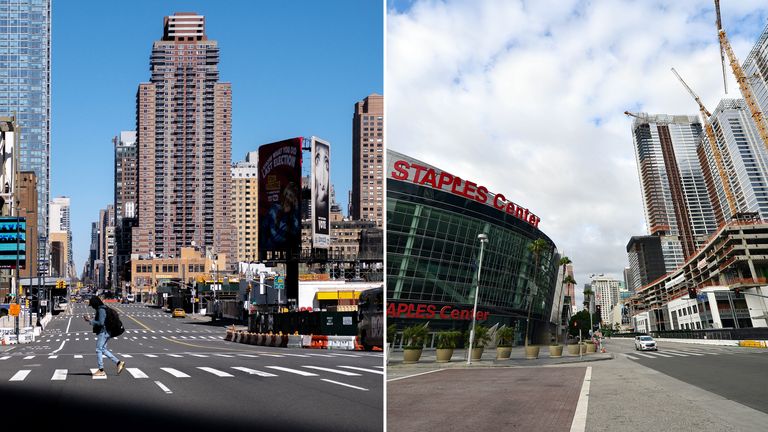
Seeing the nation’s economy going into shock, in March of that year, Trump proposed to Congress a $1.2 trillion relief program for medical research … but also for struggling businesses and state unemployment insurance programs. But the Democrats stalled on the matter, demanding instead a $2.5 trillion program, which included education programming, environmental support and other Democratic Party social-political goals … and the cutback of the financial support for American industry that Trump wanted. To get any action at all, Trump finally agreed to a $2.2 trillion program, shaped largely along Democratic Party lines … and ultimately also a grant of $1200 or $2,400 to every household, depending on single or double adult status. And there would be even more federal spending justified by the Covid crisis.
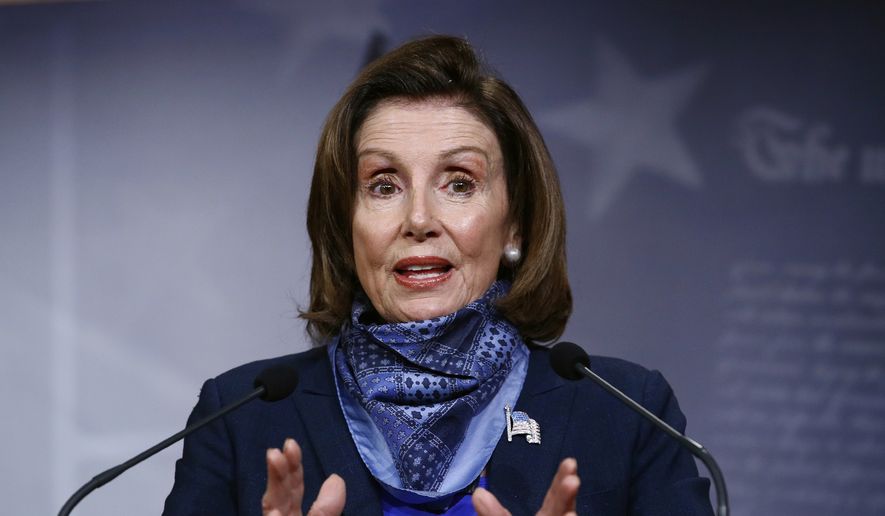
Pelosi explaining the Democratic Party’s much greater financial demands in the economic relief program
It was an election year … and the Democrats were well aware that the American voters would be most appreciative of the Democratic Party’s generosity − even though it now drove the federal debt from $23.2 trillion in 2019 to $28.2 trillion in 2020 … a $5 trillion one-year jump caused mostly by Covid politics.”
Dark social repercussions. All of this shutdown put America in a very surly mood. In May of that year (2020), a well-publicized death of a Black man, George Floyd, being held in Minneapolis police custody,* led to a very quick Black response by way of burning and plundering of the city … then elsewhere.

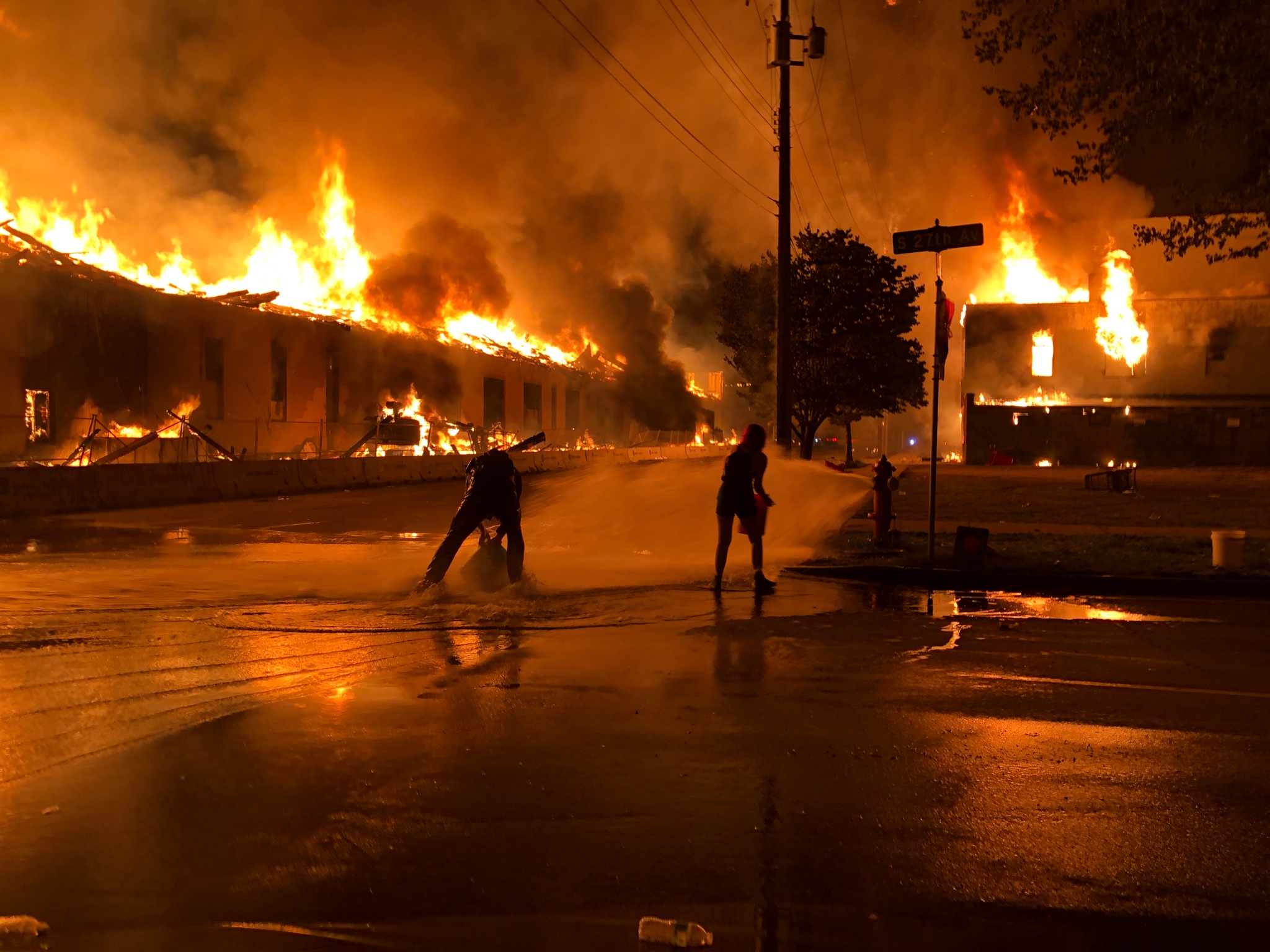
Minneapolis burning
This was accompanied by the birthing of something of an official Black protest movement, “Black Lives Matter” … which even angry Whites joined. Black Lives Matter was all about American victimhood … which given the temper of the times, everyone was feeling something of that same mood. Black Lives Matter also would become something of an ongoing member of the Democratic Party’s support groups.
Joining the Black-Lives-Matter protest movement were angry youth, mostly White, who identified themselves as anti-Fascists … their growing movement termed simply “Antifa.” And the “Fascists” they were most opposed to were the American police – police both Black and White.
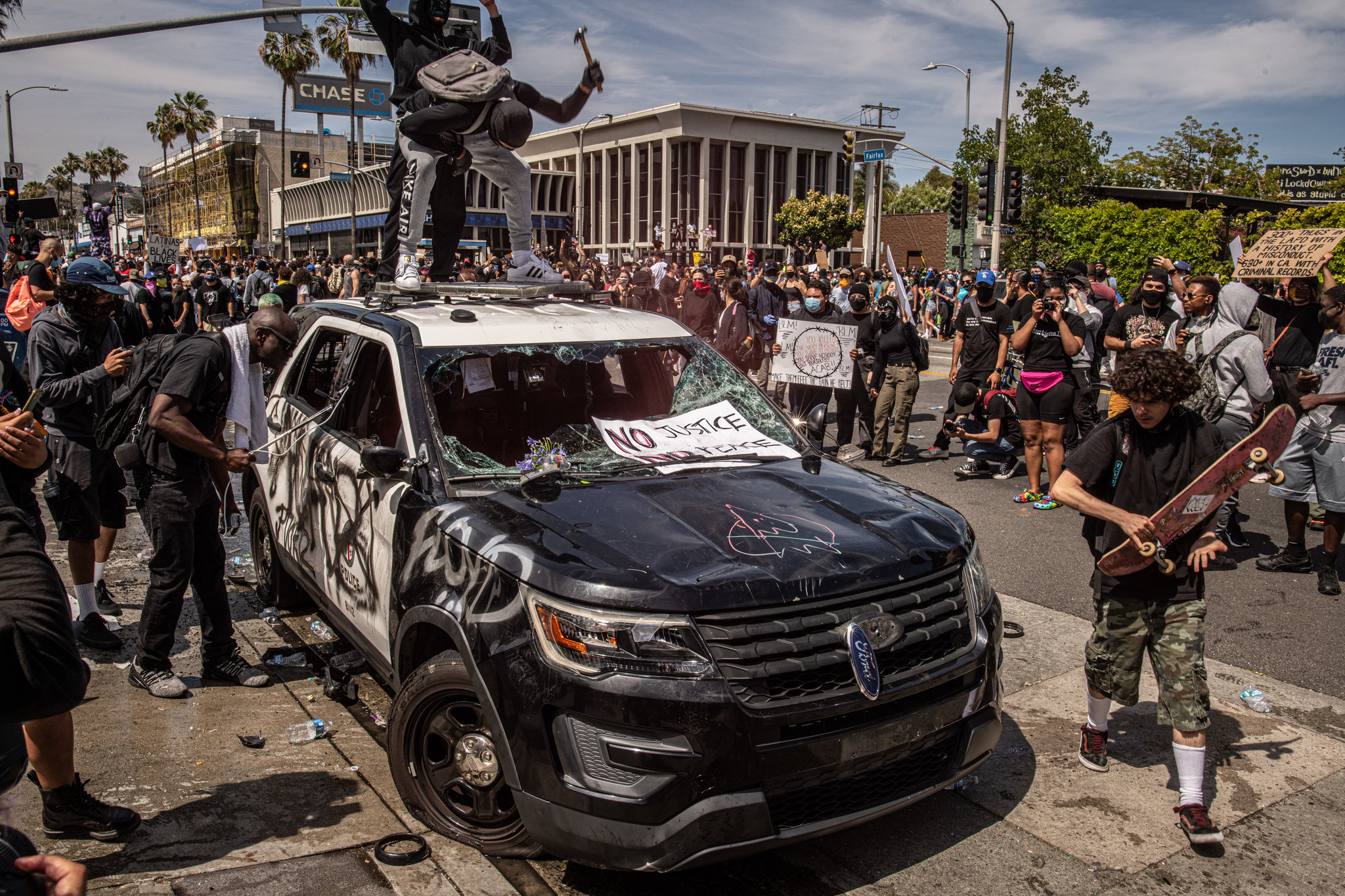
The startup of the “Defund the Police” movement … across the nation
Given the mood of the times, they actually believed that they were starting up a major social revolution. Thus it was that in June of that year, Antifa youth took control of six blocks of Seattle’s central district, and there set up a “police-free” Capitol Hill Occupied Protest (CHOP) … defended by fully-armed youth. But most unsurprisingly, shootings and other violence soon developed inside CHOP’s “police-free” realm. Finally, Mayor Jenny Durkan, who had originally been fairly supportive of the venture, ordered CHOP to be shut down. At this point, Antifa instincts simply moved elsewhere.

Antifa youth are permitted by city authorities to set up their CHOP in central Seattle
At the same time, a number of big-city mayors (Liberal Democrats mostly) joined the mood, announcing that they would be cutting back funding on their police budgets … and placing those funds in more “socially sensitive” minority-support programs. Soon “Defund the Police” became something of a politically-correct political movement itself. Not surprisingly, criminal behavior, already impacted by the anti-authority mood, skyrocketed across those same cities.
The Supreme Court continues to move America Leftward
Unfortunately, barely noticed at the time because of the drama going on elsewhere, in June of 2020, the Supreme Court announced its 6-3 decision in the Harris Funeral Homes v. Equal Opportunities Commission. With Gorsuch now taking the Liberal side of things, it was decided that the 1965 Civil Rights Act was violated when the funeral home demanded that its employees dress according to their actual physical sex when meeting with grieving family members. Although transgender rights were not mentioned in the 1965 act, according to Gorsuch it should be understood that transgender individuals had the same protective rights.
So the Supreme Court took one more step in undercutting very traditional Middle America’s Christian understanding of sexual dynamics … and how they were to be shaped so as to develop properly. But “proper” no longer had any meaning. The now “correct” social path was simply what an individual felt inclined to be and to do at the moment.
This was thus simply another victory for the Secular-Humanist Left in pushing even further its own social-moral agenda … through the Supreme Court of course.
The 2020 national elections
Trump, of course, planned to run for reelection. And the Democrats, after a long uphill run for him, finally chose Obama’s former vice president, Joe Biden, to fill the Democratic Party slot. And by Biden’s own understanding of Democratic priorities, he knew to pick as his running mate, a “woman of color” … who turned out to be Asian-American California attorney Kamala Harris.
Not surprisingly, just as it shaped so much else about American society’s doings at the time, the Corona-virus pandemic would have a huge impact on the way the national campaigns and elections moved ahead.
In the campaign itself, Trump and Biden were scheduled for three debates. The first one, in late September, was a repeat of Trump’s shameless round of insults of his opponent (with Biden and moderator Mike Wallace joining in the game) rather than any serious discussion of policy issues. This did not work well for Trump.
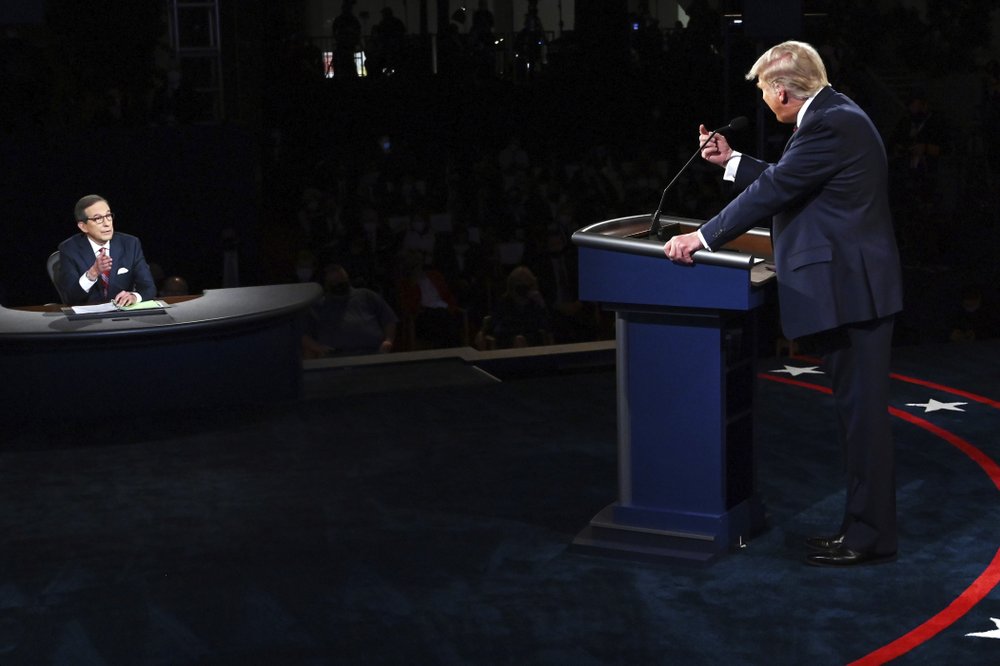
Trump and Wallace actually debating!
Any possibility of cleaning up Trump’s act with the second debate in early October got cancelled when Trump himself contacted a case of the virus and had to be quarantined. This also cut deeply into Trump’s ability to attend key rallies. And when the third debate came to pass in late October, Trump was more businesslike in his handling of matters.
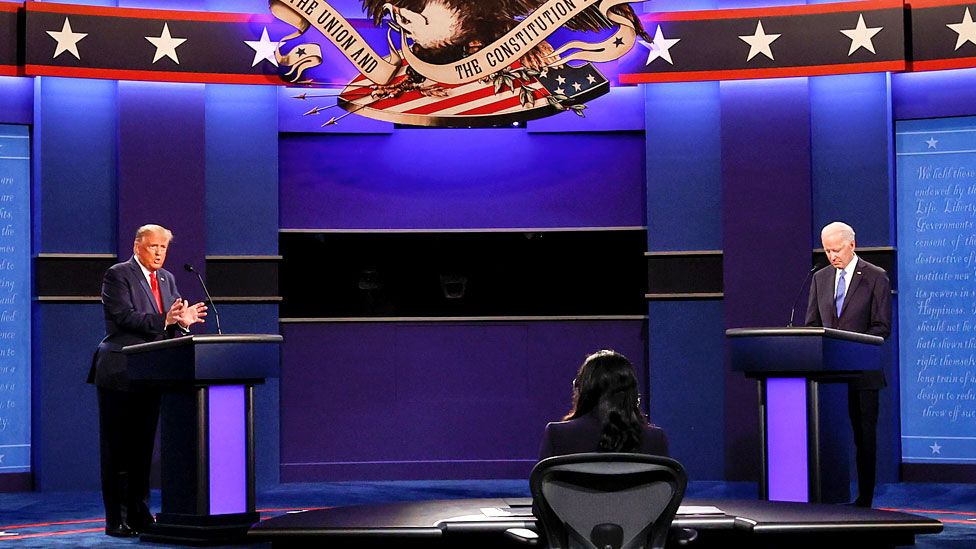
But by that point the audience was small … and most independents had already made up their mind as to how they were going to vote.
With the quarantine still widely in effect across the nation, it was clear that the election would take place mostly by mail-in ballots rather than visits to election centers. And it was well-known by both sides how such an approach to the election would impact things, Republicans known to be fairly consistent in their voting turnout, Democrats not so much. But mail-in voting would facilitate greatly the process of voting itself, clearly benefiting the Democrats.
Trump was very upset about all this … although there was little he could do about the matter. He complained loudly about how mail-in voting led so easily to fraud, simply because the actual voter could not be verified. And he felt that even illegal immigrants (loving the Democratic Party’s Socialists instincts so familiar to them) could slip themselves into the program to vote Democrat.
In any case, the vote was held (actually over the course of several days because of the mail-in process) in early November. And the results went strongly in favor of Biden, 81 million votes for him and 74 million votes for Trump … the largest number of votes ever cast … Trump’s 74 million itself larger in number than any previous candidate. And the electoral vote went 306 for Biden against 232 for Trump. But Trump was just not ready to admit that he had lost the election.
Trump now began his complaints that the election had been most fraudulent … even though his own Attorney General William Barr announced that an extensive FBI inquiry into the matter produced no evidence of extensive fraud. He pressed the case, most notably in Georgia, Michigan, Nevada and Pennsylvania … and got nowhere – except to undercut the vote for Georgia Senator David Perdue, when in a runoff election, disgusted voters turned Perdue’s lead into a loss. This also meant the loss of the slim Republican majority in the Senate to now a mere tie (with newly elected Democratic Vice President Kamala Harris able to break any tie, in favor of the Democrat position).
Sadly, none of this really registered on Trump. The only thing that mattered to Trump was that he was supposed to win the election. And he would accept no other verdict, no matter how the voting went.
Then the situation turned even uglier, when – on January 6th − Congress assembled to make official the results of the election. At that point Vice President Mike Pence had already refused to use his position as chair of the Senate to block the certification of the electoral results … ending the Trump-Pence relationship completely.
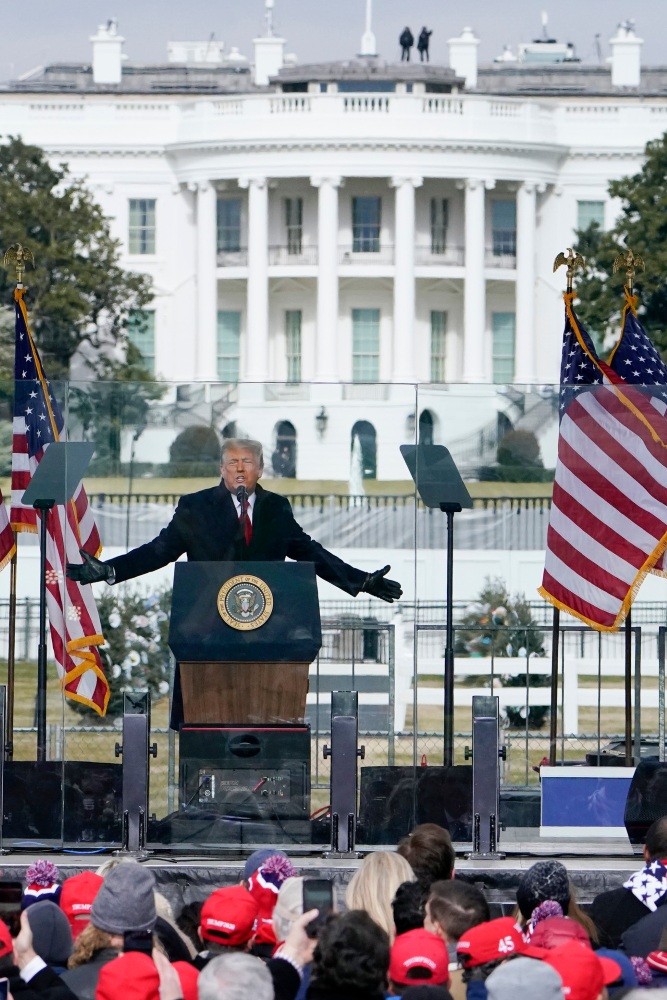
Trump then decided to have a rally protesting the Congressional certification, and subsequently sent his protesters to Capitol Hill to voice their outrage. But the momentum carried the protesters on into the building itself, sending gathered Congressional members scrambling for safety, accompanied by a shooting death of a protester and the beating and subsequent death of a Capitol Hill policeman and numerous other injuries (and deadly health failures of a few others).
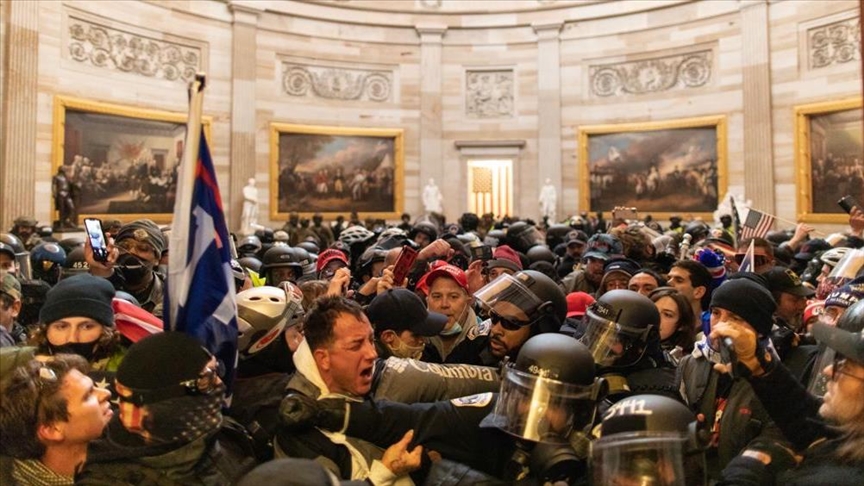
With this, a call for impeachment for Trump got quickly underway … and the House soon (January 12th) enacted impeachment.
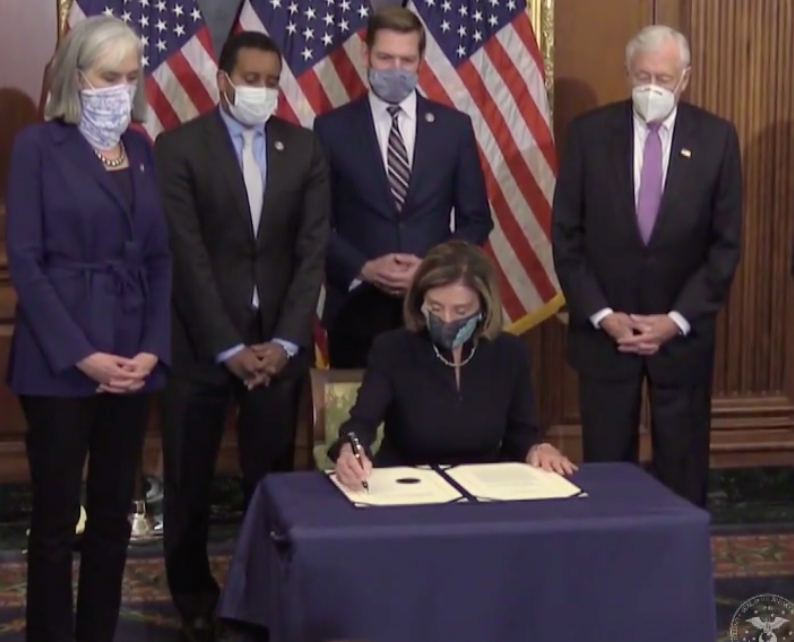
But Republicans in the Senate (though some had joined the Democrats on the matter) kept the matter from going any further with a mere 57-43 vote, thus falling short of the 67-33 (2/3rds) vote needed to convict.
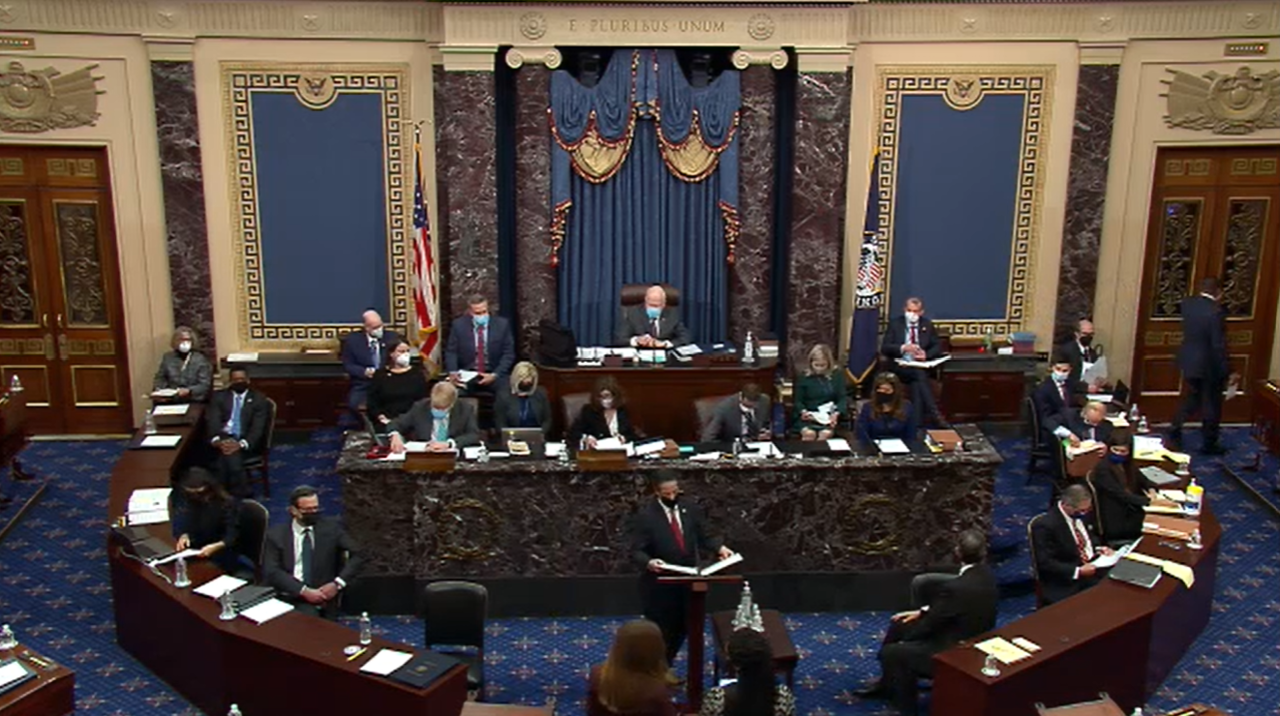
THE BIDEN PRESIDENCY
The making of Joe Biden
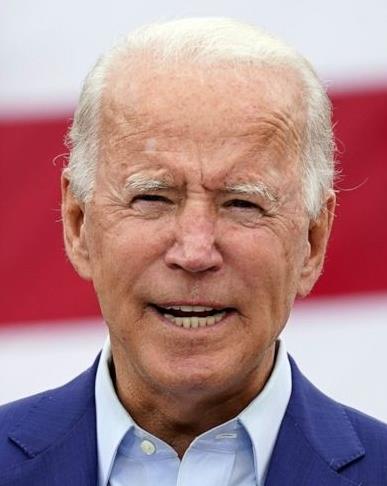 Just as much as Trump was a total “Washington outsider” Biden was a total “Washington insider.” Since (at age 30) he had been elected to the U.S. Senate representing nearby Delaware, for nearly half a century his world was built fully on the D.C.-Delaware link. Indeed, by the way he went at things, his home in nearby Wilmington seemed to be no more than a part of D.C.’s suburbs.
Just as much as Trump was a total “Washington outsider” Biden was a total “Washington insider.” Since (at age 30) he had been elected to the U.S. Senate representing nearby Delaware, for nearly half a century his world was built fully on the D.C.-Delaware link. Indeed, by the way he went at things, his home in nearby Wilmington seemed to be no more than a part of D.C.’s suburbs.
He was a Democratic Party supporter through and through … again almost in the same way that Trump was never a Republican but merely a through and through Trumpian. Biden lived to serve the Democratic Party − almost religiously (quick to take the Democratic Party view even when it contradicted his supposedly Catholic beliefs) … in the same way that Trump lived so that the Republican Party now served him.
Biden was born in Middle America to an Irish-Catholic family in Pennsylvania in 1943, his family moving to Delaware when Joe was 13, for his father to work there as a used-car salesman. Biden grew up along fairly typical lines, majoring in political science (and sports, girls and parties!) at the University of Delaware, went on to law school at Syracuse University, and met and married Nelia Hunter in the process.
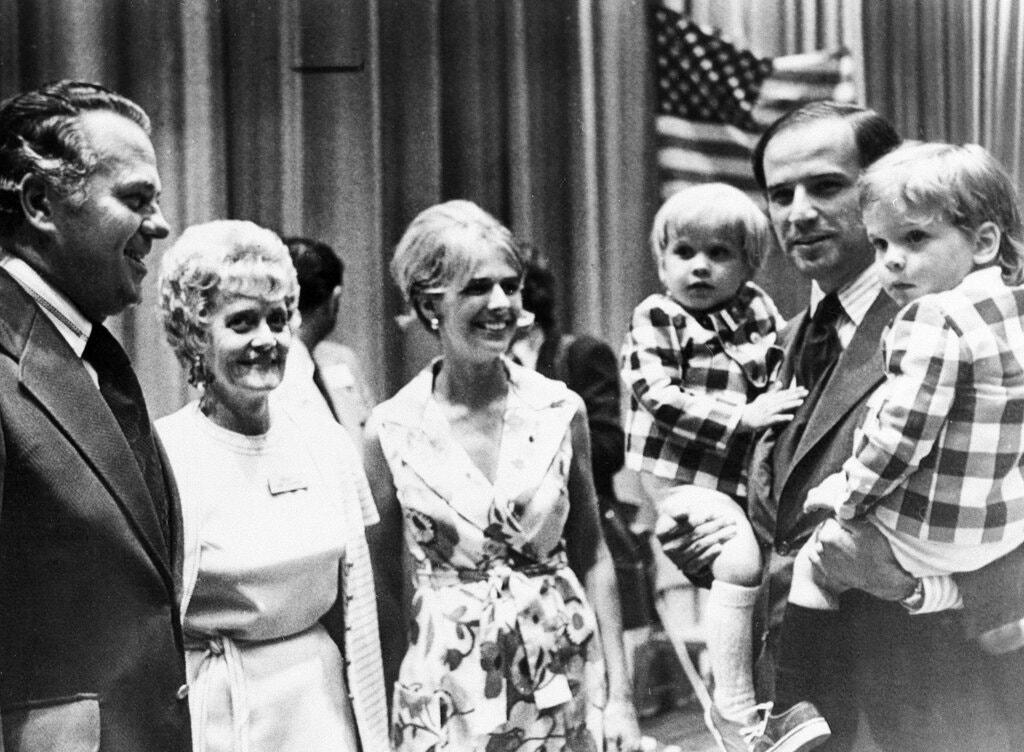
Biden with family … Nelia and their sons Hunter and Beau
He quickly found the law practice to not be his thing, but took an interest in politics … and won a position on the New Castle County Council in 1970. Then two years later (at only age 29!) he decided to run for the position of US Senator. And, with a lot of effort on his part, he defeated the incumbent Senator Caleb Boggs, gaining 50.5% of the vote.
But tragedy hit him deeply that same year when Nelia and their baby daughter died in a car accident while they were out doing Christmas shopping. His two small sons, Beau and Hunter, in the back seat, were injured badly and hospitalized. Biden thought about quitting … everything. But Senator Mike Mansfield worked hard to get Biden not to quit and instead take up that calling as a U.S. senator. And so he did … being sworn into office at the hospital bedside of his boys rather than in D.C.

Slowly he rebuilt his life around his service as a U.S. senator … and to the Democratic Party − which became something of a political home to him. And he grew close to Carter when Carter took up his own path to the U.S. presidency. They would subsequently work closely together. And in 1977 he would also marry Jill Jacobs, who would be a major source of support for him.
Joe and Jill were quite Catholic in religion … which Joe often made very clear.

Jill and Joe meet Pope John Paul II at the Vatican – April 1980
He slowly worked his way up the senatorial seniority ladder, finally becoming Senate Judiciary Committee chairman in 1987 … and deciding that same year to make a run as a Democratic Party candidate for the U.S. presidency. But things did not go well for him, he suffered a huge health setback in 1988 … which even kept him out of the Senate for seven months. But back in the Senate, he was able to block Reagan’s appointment to the Supreme Court of the quite conservative Robert Bork that year. He also, in 1991, tried hard to block Bush’s appointment to the Supreme Court of the Black conservative, Clarence Thomas.
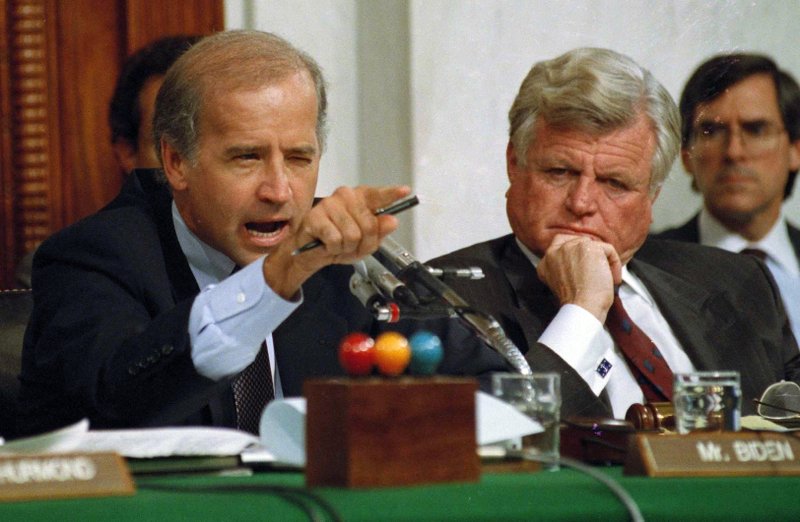
Biden taking Anita Hill’s side in the Thomas hearings … accusing Thomas of improper behavior (sitting next to him is “Chappaquiddick Ted” Kennedy … the model of proper behavior)
Then in 1997 the realm of foreign diplomacy loomed large for him when he became the ranking minority member of the Senate Foreign Relations Committee … then its chair in the years 2001-2003 and 2007-2009. In those years he supported American intervention in Afghanistan and Iraq … but backed away from that support when things did not go well in Iraq. He thus also opposed the “troop surge” of 2007 … which actually settled things down considerably in Iraq.
He would make another run for the presidency in 2008, but have to soon drop out when he was able to get little support. But Obama saw in him the “balance” he needed in order to get Middle American support … though as Vice President, Biden got very little attention during the 2008 campaign (unlike Sarah Palin!). But with Obama’s win in 2008, Biden got some of the national attention he hungered for … particularly when Obama called on him to use his contacts in Congress to help pass the economic measures Obama was trying to put in place in response to the economic crisis in those early years of Obama’s presidency. But during Obama’s second term, with the Republicans in charge of Congress, Obama found Biden to be less useful.
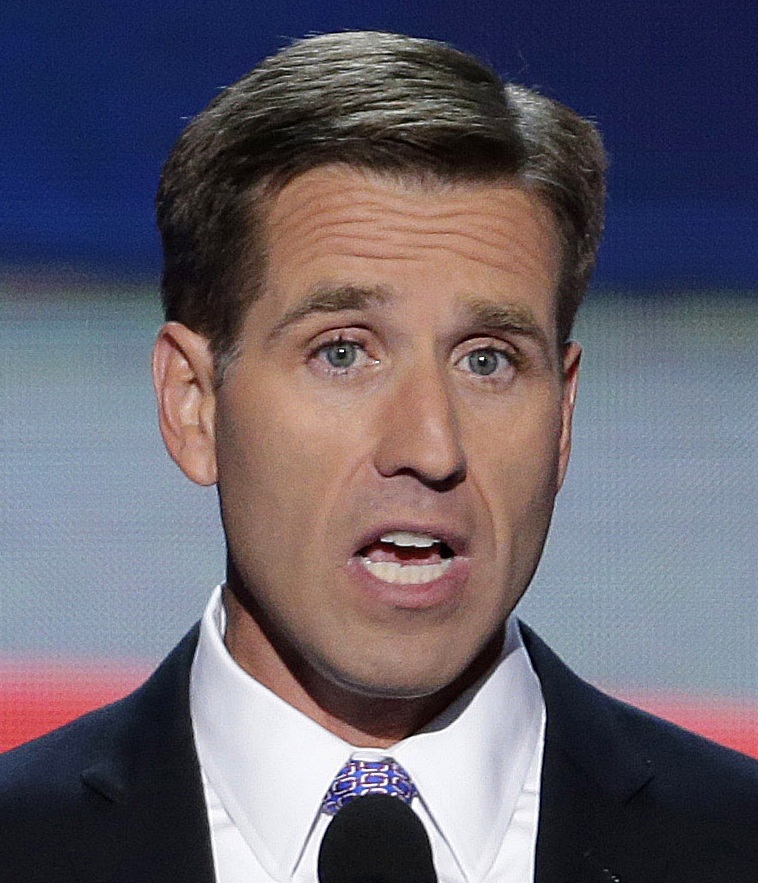 But tragedy would strike Biden again when in 2015 his 46-year-old son Beau died of cancer … a huge blow not only to Biden but to many others (even the people of Kosovo) that Beau had personally encouraged and supported.* At this point, Biden abandoned plans he had to run for the presidency in 2016 … and threw his support to Hillary.
But tragedy would strike Biden again when in 2015 his 46-year-old son Beau died of cancer … a huge blow not only to Biden but to many others (even the people of Kosovo) that Beau had personally encouraged and supported.* At this point, Biden abandoned plans he had to run for the presidency in 2016 … and threw his support to Hillary.
Over the next couple of years Biden taught at the University of Pennsylvania, wrote a memoir, Promise Me, Dad, and did a lot of public speaking … and prospered greatly from both the book and the speaking. Then in 2019 he announced a new run for the presidency … many noting however that if successful, he would be taking office at the age of 78 … six years older than John McCain would have been if he had been elected president in 2008! To the Democrats, that “old age” concern no longer seemed to be any kind of a problem!
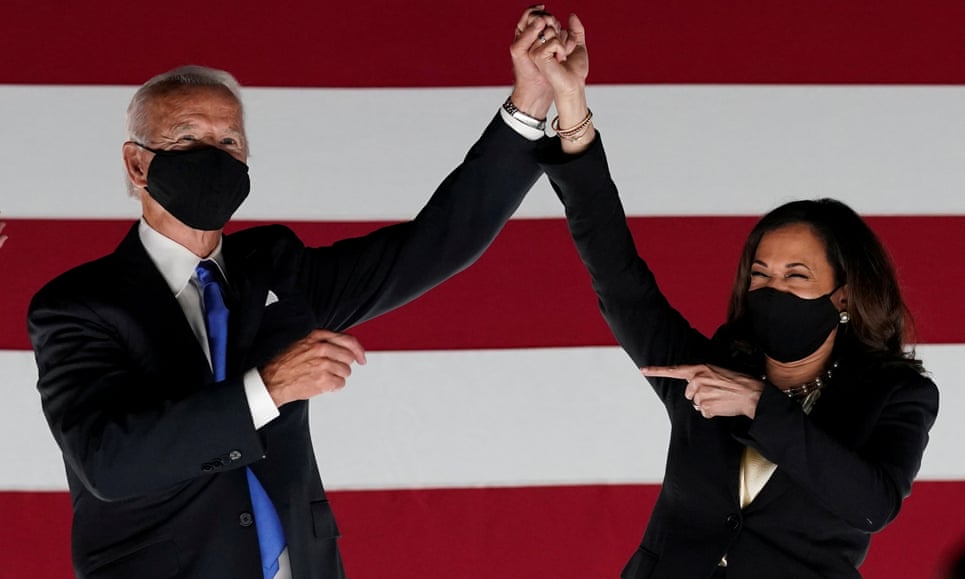
Biden announced that his running mate would be a “woman of color.” In March of 2020 he declared Kamala Harris to be the one to fill that spot.
Obama’s “Change” continues under Biden
Biden seemed to rise above the divisions that were crippling American politics when in his inauguration speech he announced that he intended to serve as president of all Americans and not just those who elected him.
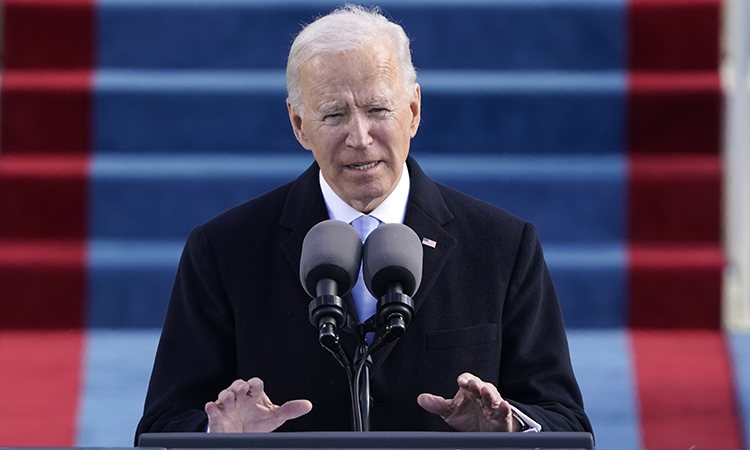
But sadly, that position did not last long, because only a few hours later, with his staff gathered around him (wearing face masks and standing 6 feet apart as part of the Covid protocol) he signed one, then another, executive order (17 in total) … all designed to undo the Trump economic and social legacy – and return things back to where they stood under Obama.
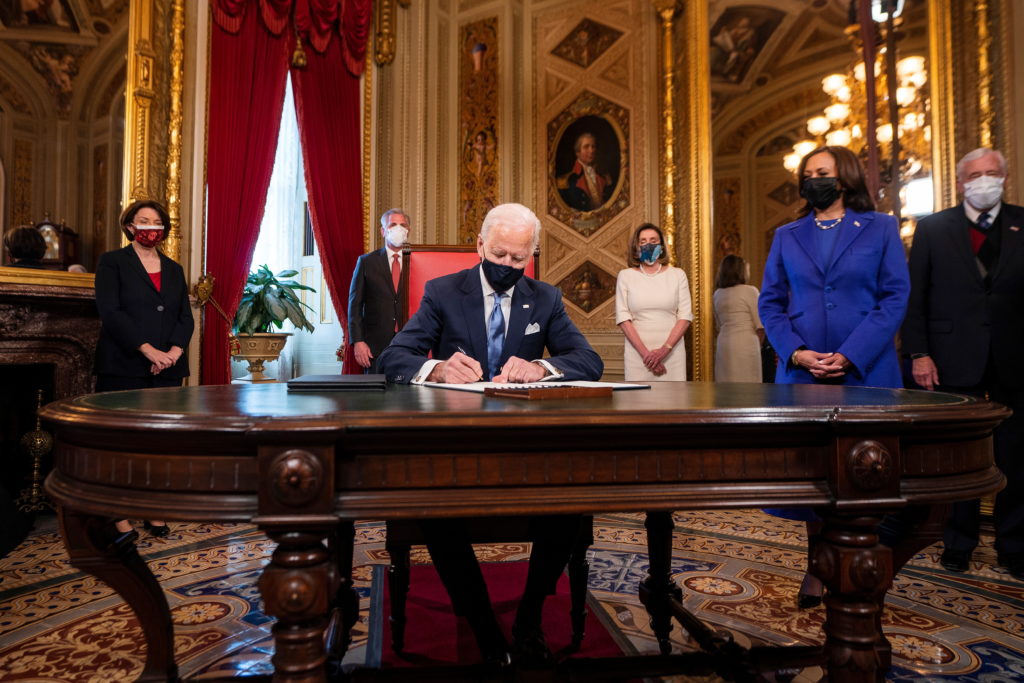
Immigration. Also, having made clear earlier his view that Trump’s tough border policy was most unfair and that he, Biden, was going to do away with such a policy, his inauguration then became the signal for the flood of immigrants to begin a rush on the American borders … the numbers exploding in size – over 170,000 in the month of that March alone.
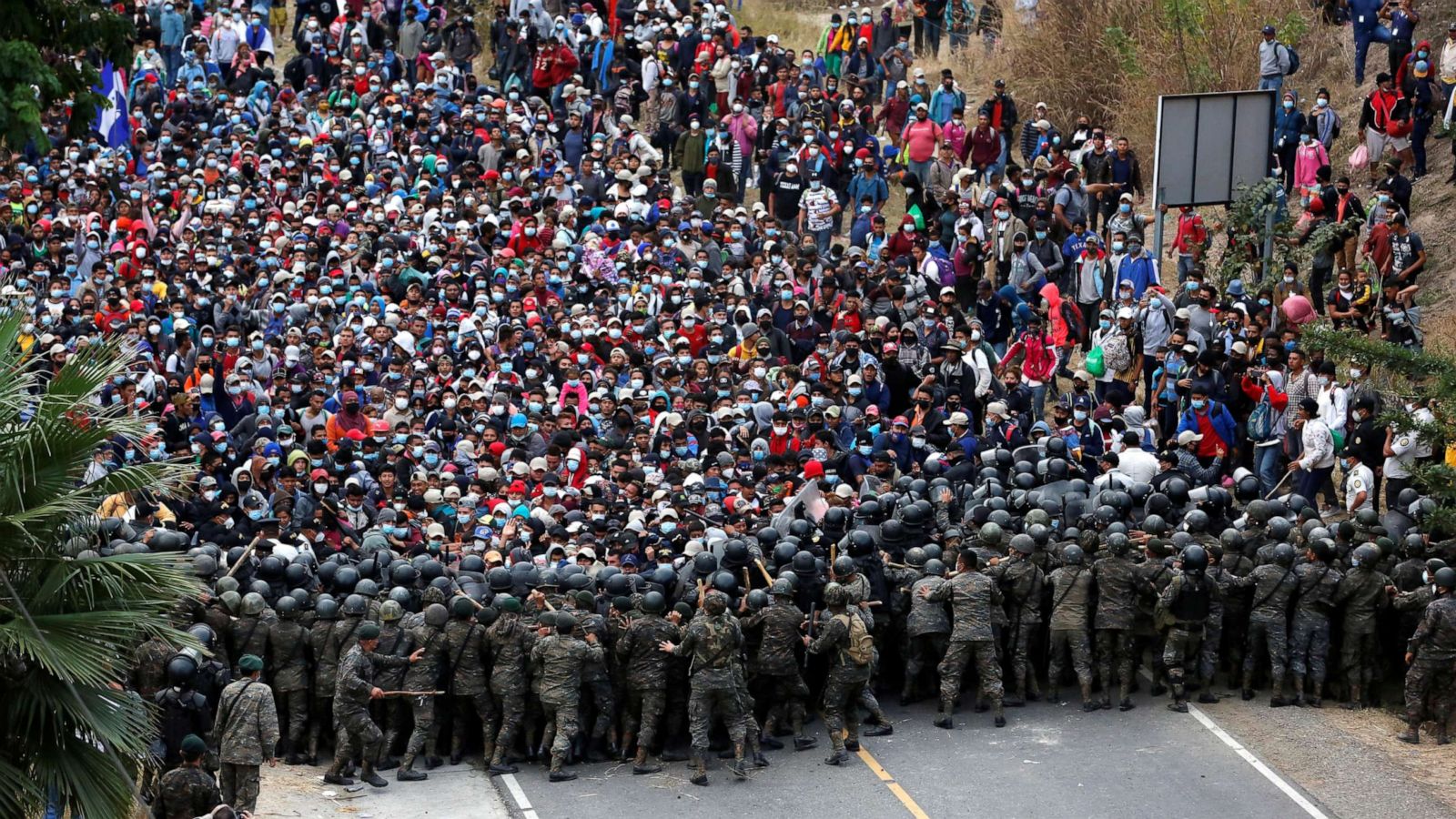
Hondurans attempting to move north to America – January 2021
And that number would not let up over the coming years. Thus at the end of September of 2023, it was noted officially that some 3 million people had crossed the border during the previous fiscal year, 142,000 having done so illegally during that month of September.
All of this was changing the ethnic-cultural character of the country … as fully intended by the Democrats (seeing these immigrants as future Democratic Party voters). Thus … in 1965, under Johnson’s Immigration Act, some 9.6 million foreign-born individuals were living in America … some 5 percent of the population. By the year 2000, there were over 30 million immigrants living in America – one-third of whom just arrived in the 1990s. And by 2020, that number reached approximately 50 million individuals, most of them (77%) legally … the rest in the country as “undocumented” residents. And now that growth was increasing even more rapidly.
“Infrastructure development.” Biden would push hard to get the Democratic Party’s “infrastructure development” back under way. He wanted more welfare support to help local governments burdened with the costs of providing care for the masses of immigrants being settled in their cities. And he pushed hard for programming to move American energy usage from hydrocarbons to renewable solar, wind, and other energy (non-nuclear) forms. But the Republicans were willing to go along with Biden only in matters of “physical infrastructure,” such as roads and bridges. Consequently, Biden would find that he had to push ahead simply by issuing more executive orders.
A rapidly rising national debt. But “consequently” also was the further run-up of the national debt. By the end of 2023 it had hit the remarkable figure of $33 trillion, with $1 trillion being added to it every three months at that point. Something drastic needed to be done to slow down this fiscal horror. But what?
Biden’s Supreme Court appointment. When Stephen Breyer retired from the Supreme Court in 2022, most unsurprisingly, Biden looked to yet another “woman of color,” Ketanji Brown Jackson, to fill his vacated position … although it simply amounted to the replacing of one political Leftist with another of the same political outlook.
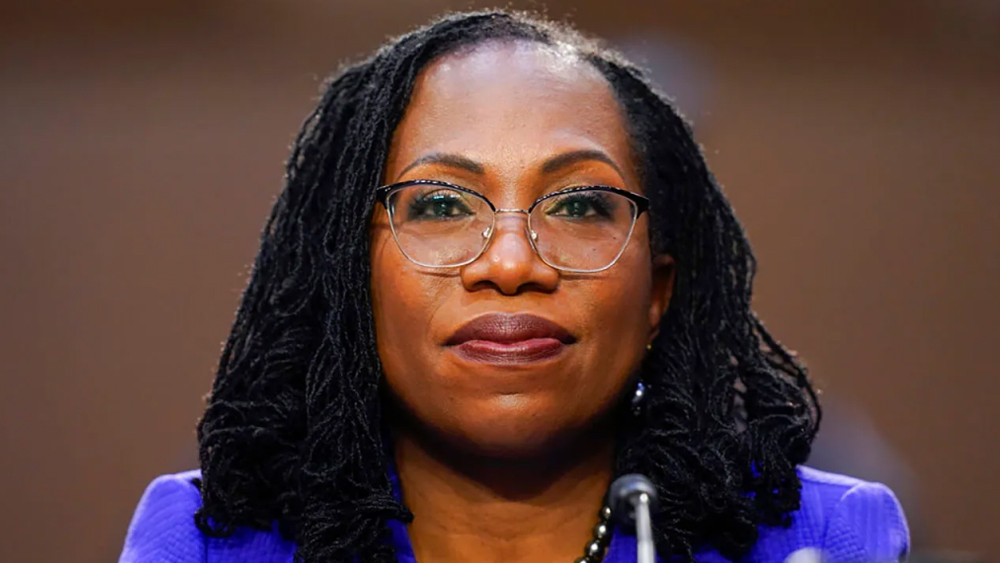
International issues during the Biden years
American intervention in the affairs of other countries – at least direct military intervention – had pretty much come to a halt over the past decade. But as a global superpower, there was no way that America would not find itself involved in some way or other in dramatic events developing here and there across the world.
The disastrous withdrawal from Afghanistan. Under Trump, there were plans – developed in February of 2020 with some kind of agreement with the Taliban – for a full American withdrawal from Afghanistan. Thus Trump began a troop drawdown … with a full pullout scheduled for May of 2021. What kind of political order years of Western effort in Afghanistan the pullout would leave behind was not discussed. And indeed, whatever Trump had in mind by way of a Western legacy in Afghanistan would never be known … because Biden, not Trump, was in the White House that next year.
And Biden decided to go ahead with the pullout, but scheduled it for that August, not that May. And Biden believed that the Taliban would indeed respect whatever terms had been agreed on for a peaceful transition to … to what?
And thus the pullout happened as scheduled … but without any careful preparations beforehand … thus taking place in a chaotic rush, rather than as an orderly departure. Not only were vast amounts of American military equipment left behind in the rush, so were countless pro-Western Afghans, Afghans who would now have to face the wrath of a very anti-Western Taliban political order. It was a shameful departure … one, however, that the American media quickly passed over.
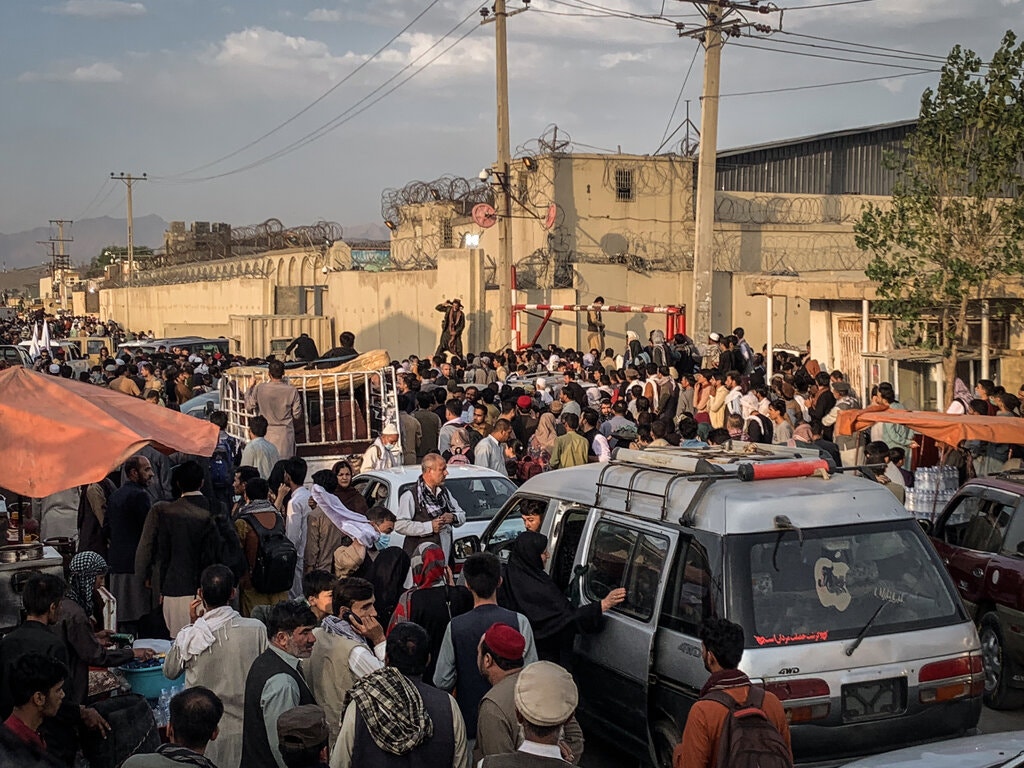
China had to be loving to watch America sneak off from a serious global responsibility … quick to bring notice to the rest of the world that it would be wise not to put trust in America’s promise of great-power protection. And indeed, America was not looking at all like a great power at that point.
Russia attacks Ukraine. A conflict between Russia and Ukraine had been going on for quite some time, Putin refusing to recognize Ukraine as an independent nation … and supporting Russian-speaking separatists bent on splitting off the Russian-speaking portion of Eastern Ukraine (principally the Donetsk and Luhansk oblasts) as either independent countries – or even as lands rejoined to Russia. But Ukraine would have none of that and had sent troops to counter the separatists … and the Putin support they were getting. Thus in the period 2017-2019, it appeared that things had settled back under Ukrainian authority. But the conflict continued … at least on a small scale.
Then in February of 2022, Russian troops invaded Ukraine … as Putin explained, to “de-nazify” Ukraine. At the same time, Russian missiles hit hard Ukraine’s capital Kyiv (and other sites).

In general, the world reacted strongly against Russia, the United Nations General Assembly (not the Security Council where Russia had a veto) demanding that Russia withdraw immediately from Ukraine. The International Court of Justice responded in a like manner … even eventually (2023) issuing an arrest warrant for Putin. But most importantly, Biden, joined by Canada and the European Community, moved quickly to put economic sanctions in place against Russia … and ultimately to start shipping military items to Ukraine. But notably, most Third World countries did not join the sanctions. But neither did Serbia and NATO member Turkey … nor did China or India.
But most surprising was Ukraine’s ability not to collapse under the Russian assault … but to fight back boldly – thanks to the leadership the country had under its president, Volodymyr Zelensky. With Ukraine not collapsing as Putin had hoped, the Russians were ultimately forced to pull back troops in the Ukrainian north … although they held their ground in the Russian-speaking territories of eastern Ukraine.

A true leader (Zelensky above) versus a nervous dictator (Putin below)
Meanwhile, the killing and wounding of Ukrainians (and Russian soldiers) continued as the war dragged on, as of mid-2023 some 16 million Ukrainians being forced to flee their homes … half of those leaving the country as refugees.

Putin willing to destroy Ukraine … in order to bring it to submission – 2023
And Biden (and his European allies) continued to send military items in vast numbers (ammunition, missiles, tanks, helicopters, planes) to help Zelensky … at least to hold the line (advancing against the Russian position in eastern Ukraine was just not possible). And that’s where things stood, all the way to the end of Biden’s four years in office.
Israel and Hamas go at each other. In early October of 2023, without any warning, the Palestinian political organization Hamas, sent battalions of its militants from Palestine’s Gaza Strip into southern Israel, killing some 1,400 civilians … and abducting 251 people as hostages. And they took pictures to impress the world with their well-intended cruelty.

But what it was that Hamas thought it could ultimately achieve in all this remains a mystery. Israeli Prime Minister Benjamin Netanyahu was not going to be intimidated … but in fact rise to the occasion as an even stronger leader – morally self-authorized to strike back deeply at Hamas, and the Palestinians supporting that organization. Basically that was considered by Netanyahu to be the entire population of Gaza.

Thus the Israeli response was even more destructive – grandly more destructive – than what Hamas had just carried off. Nothing was exempt from Israeli bombing, not homes, not schools, not hospitals … all justified because Israel claimed that these were also hiding places for Hamas operatives.

America quickly split along pro-Israel and pro-Hamas lines. Since the mid-1960s, American support had gone most unquestionably to Israel, in its many conflicts with its Arab neighbors. But sympathy had been recently growing in favor of the Palestinians … because it was increasingly understood that the Palestinians (Christians as well as Muslims) had been treated rather cruelly by the Jews who moved massively from Europe to Palestine at the end of World War Two … and had continued to expand their population (despite repeated agreements to limit that expansion) ever deeper into the lands that the Palestinians had formerly (since ancient times) inhabited.
Most interesting, conservative (or “evangelical”) Christians felt that it was their duty to support Israel … having little actual understanding of how that very support had been responsible for shutting down the Gospel Light in the Holy Lands when Jews drove Christian Palestinians from their towns and homes. And also most interestingly, it was now younger, more Liberal Americans determined to finally bring support to the Palestinians … those suffering massive destruction of their world by Israeli bombardment and other military action.
And Biden tended to play something of a middle man, even immediately flying to Israel to try to work out some kind of settlement between the warring parties (although mostly he seemed to be supporting Israel). But nothing came of that effort. Indeed, ultimately, America had no serious role to play in this grand tragedy … a tragedy that continues (like the Ukraine crisis) to drag on.
THE TRUMP PRESIDENCY – ROUND #2
Trump was quick to ensure that he would be the only Republican presidential contender for the 2024 elections … against an “aging Biden” (who was actually only a few years older than Trump).
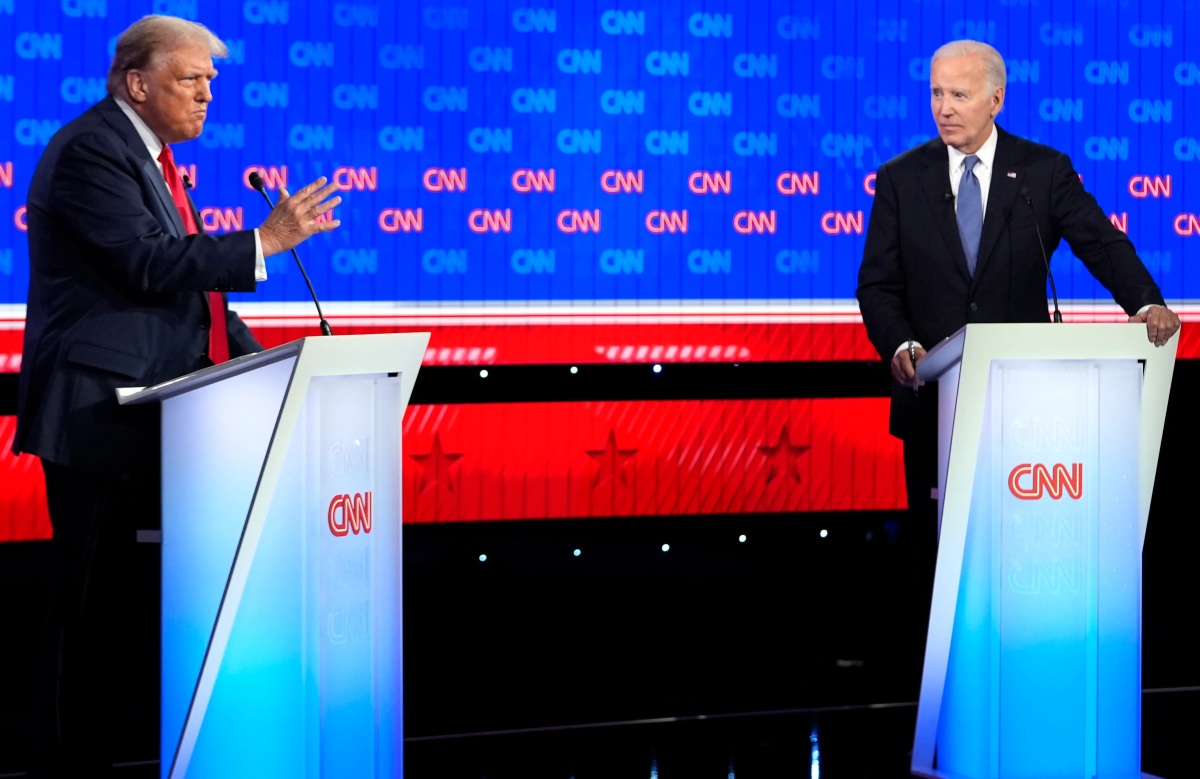
In their only debate, things did not go well for Biden – June 27
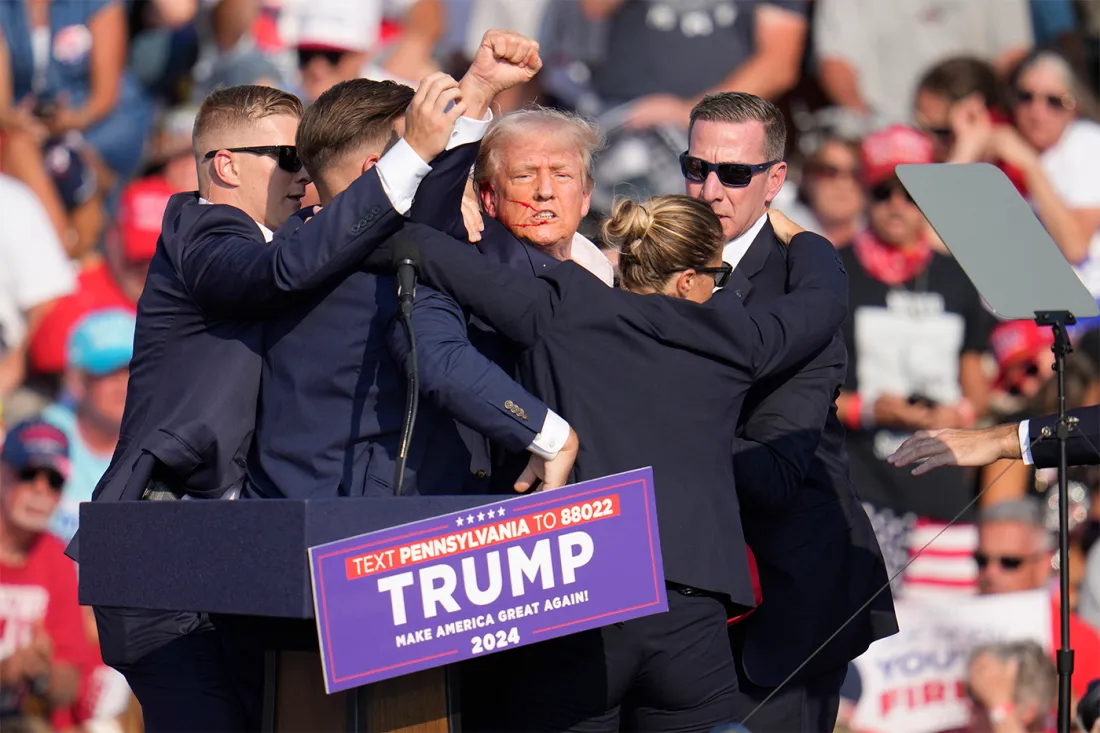
And an assassination attempt (July 13th) served merely to increase Trump’s support
Then as the election itself approached, Biden was forced by his party to drop out because of the growing concern about his age – and his seemingly dwindling intellectual capacity − and leave the candidacy to his Vice President Kamala Harris.
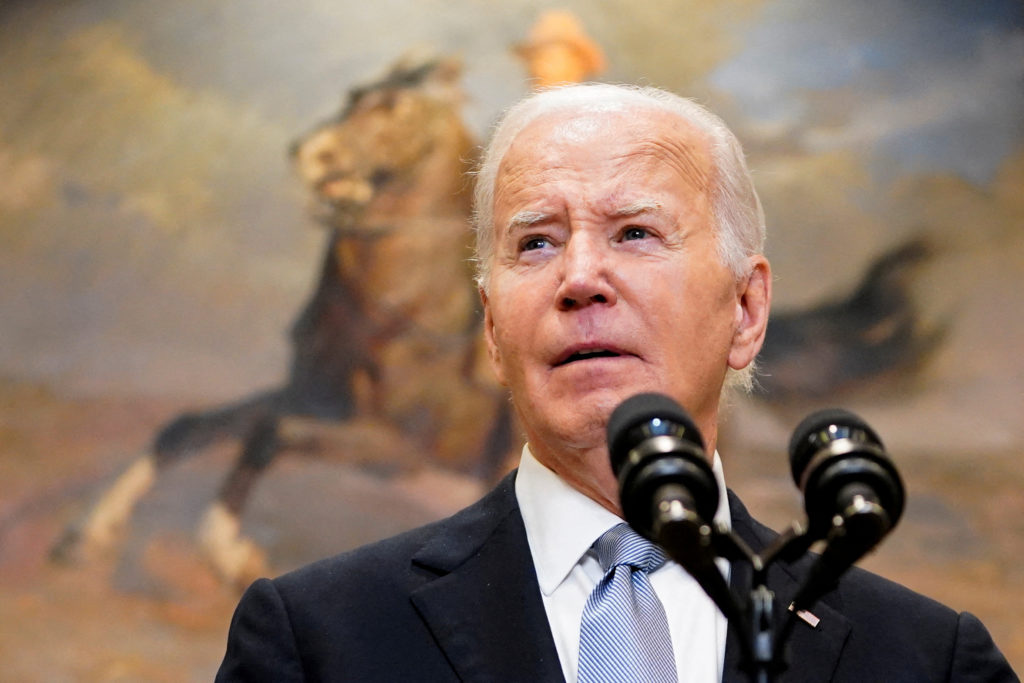
But none of that impressed greatly the American voters, who returned Trump to the presidency with a rather significant majority – and with the Republicans picking up additional seats in the Senate (now 53 to 45 seats) … and with the Republicans still holding a small lead in the House, 220 to 215, despite the Democrats’ gain of two seats.
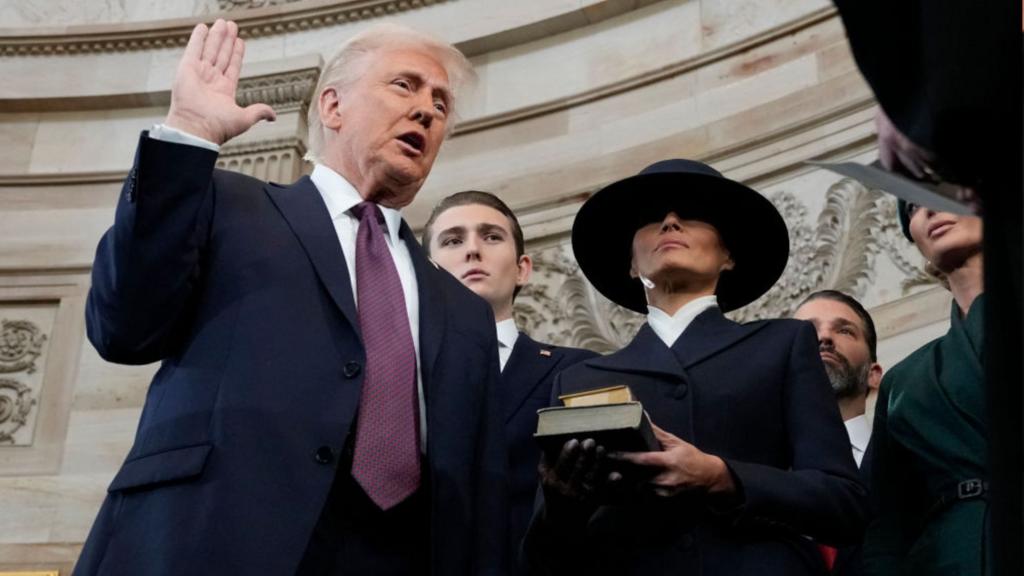
And Trump intended to come on strong during his first 100 days, something like FDR with his New Deal … though things were not pressing the country as hard in 2025 as they were in 1933.
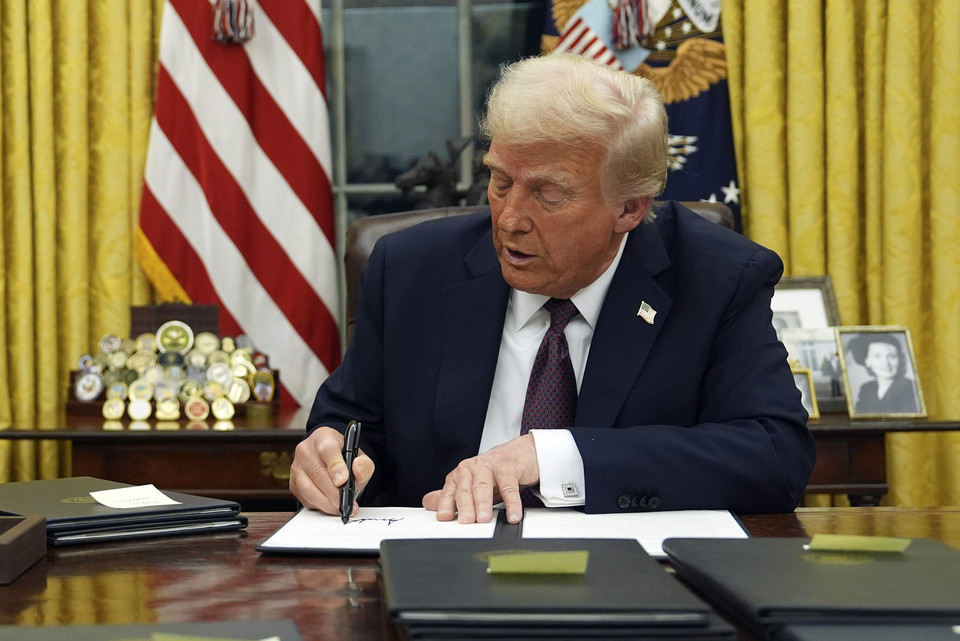
But Trump seemed more determined than even previously as U.S. president to do things the Trump way. Thus he announced that the Gulf of Mexico was to be officially renamed as the Gulf of America, that it was time to take over the very strategic country of Greenland (to be taken away from America’s NATO ally Denmark), and that it was time for Canada to acknowledge the necessity of becoming America’s 51st state. Was he kidding? These were not issues arising from the demands of the American people themselves. Of course America’s “Trumpians” would quickly fall in line in support of these strange ideas … as was expected of them. But ultimately what was this all about?
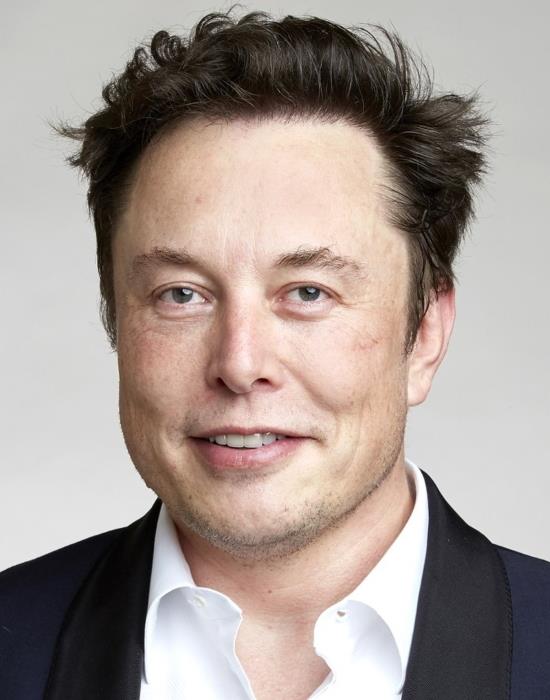 Not so surprising was his creation of the new Department of Government Efficiency (DOGE) – under the directorship of his close ally, billionaire Elon Musk. Trump assigned Musk the task of reducing the size of the federal bureaucracy, terminating the employment of numerous federal bureaucrats under various terms of dismissal. Trump even wanted the Department of Education simply eliminated. But all government agencies, from the park service to the medical services were to be cut back. His claim was that the federal government had vastly overextended itself and needed to be cut back to a more efficient size, thus reducing the federal debt … and taking powers away from a bureaucracy that should never have been granted it in the first place.
Not so surprising was his creation of the new Department of Government Efficiency (DOGE) – under the directorship of his close ally, billionaire Elon Musk. Trump assigned Musk the task of reducing the size of the federal bureaucracy, terminating the employment of numerous federal bureaucrats under various terms of dismissal. Trump even wanted the Department of Education simply eliminated. But all government agencies, from the park service to the medical services were to be cut back. His claim was that the federal government had vastly overextended itself and needed to be cut back to a more efficient size, thus reducing the federal debt … and taking powers away from a bureaucracy that should never have been granted it in the first place.
And there was his program to stop the flood of America by undocumented immigrants … Trump issuing executive orders requiring the arrest and expulsion by Immigration and Customs Enforcement (ICE) agents of all illegal immigrants. But that particular issue Americans understood quite well, because it had been such a long-standing issue. And Trump’s new orders on the matter did have the rather immediate effect of bringing to something of halt the rush for American borders (although the business of illegal entry by human traffickers across unprotected areas of the border would most likely continue … though probably at a reduced rate).
But it also raised serious questions about the ICE grabs of individuals without any legal hearings on the matter, including individuals long- resident in the country. How was this legal? Thus most unsurprisingly, and very quickly, Trump’s executive orders on this matter found themselves challenged in the media … and in various district courts. And ultimately this served to undercut his relationship with the generally pro-conservative Supreme Court, which also declared his grab of immigrants to be highly illegal. Of course, though certainly most fair to those under arrest, holding hearings on every illegal immigrant found in the county (of which there were probably millions) could drag on endlessly … and give truly problematic illegals plenty of opportunity to dig ever-deeper in their criminal activities. So … who was right and who was wrong on this issue? Nonetheless, Trump himself seemed quite determined to simply ignore this “unwanted legal intervention” in this key program of his.
But his biggest project, a round of tariffs put in place rather immediately against America’s trading partners across the globe, also came as a huge surprise. And they were also shockingly high tariffs … so shockingly high that Trump’s tariff program sent Wall Street into a panicked drop in value.
But ultimately those original tariffs were finally understood to be entry-level bargaining chips … to muscle other countries into reducing their tariff and other restrictions against American imports. And the stock market began a slow climb back … as indeed, the new round of Trump tariffs did seem to have some bit of a leavening effect on those other countries’ tariffs … and thus Trump could back down a bit on those tariffs he had just put in place.
However this did not seem to have a similar effect on China – which seemed unmoved to undo its own consequent doubling of its tariffs on American goods. Also, all of this simply provided China with the opportunity to retreat further from its reliance on its economic relations with America … and develop further its own business world – especially in the high-tech realm.
Ultimately, all of this Trump presidential initiative and its impact on America remains to be seen as of this writing. Certainly the new tariffs are going to stir an equivalent inflation within the American economy. Thus unsurprisingly, America’s opposing parties are digging in for a building fight … at a time that the rest of the world seems more than willing to move on – and become much less reliant on American leadership.

Go on to the next section:
Conclusion: The Call to Again Be a Light to the Nations